Lofoten
2025-05-28 – 2025-06-09
Solo journey to Lofoten and the Islands Rost and Vaeroy. During the journey I will hike, climb, do bird spotting – I have for a long time yearned to see puffins – fish, cook, and surf. In that sense it is far from my typical type of hiking journey. I will indeed live out of my tent and my (heavy) backpack, but it is not a through hike, and unlike my traditional hikes, I now actually have to be at a certain place at a certain time due to ferry crossings. It will be exciting to see how this pans out and what I think of it.
With all the equipment (see figure), my backpack weighs in at 19 kg – and that is without food and water. This will be close to the heaviest I have ever carried whilst hiking (I have peaked at 25 kg). In addition, I’m facing volume issues, getting all of that equipment down in the sack is an extremely tight squeeze. Considering the backpack is essentially one big open sack it is also somewhat impractical – to retrieve the bottom equipment, I have to take out basically everything. If I’m hiking with this amount of equipment ever again, I will need to purchase a new backpack. Normally I would carry with me all the food I require for the hike, but this time that is not an option and I will have to make provisions and cook along the way.
The general plan is to start at Rost, continue to Vaeroy, then head to Moseknes, and end the Journey in the vicinity of Henningvaer where I will meet up with my friends Douglas and Zainab for some climbing. Just in the last year Douglas and I have climbed and traversed glaciers in the alps, we have cross-country skied in Sjusjön, ice skated in Gothenburg, hiked and climbed in Scotland, and now we are climbing in Lofoten. Where do we meet up next?
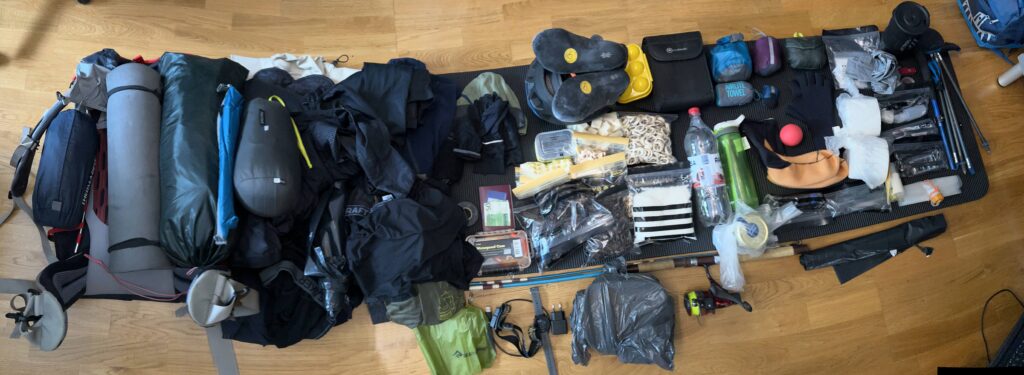
2025-05-28, Wednesday – The Journey Begins
My flight leaves Landvetter airport at 06:00 – There is no public transport that enables me to get to the Landvetter airport in time so I went directly from work and pitched my tent in the woods close to the airport. Not the best way to get some sleep, airplanes are after all relatively loud and provide an occasional smell of jet fuel. The airport security also paid me a short visit, but decided not to bother me, after all, I was in no violation of any laws or regulations.
The flight takes me to Stockholm where I transit to a plane heading for Oslo, where I make yet another transit to a plane heading to Bodö. After collecting my baggage at Bodö, I noticed that my reel had broken during the flight. Luckily I have quite a lot of time to kill before the free (yes it is free for foot-passengers) ferry taking me to Rost departs. After a short walk to XXL I have a new reel and some much needed gas for my hiking kitchen.
While waiting for the ferry, I tried cooking some food using my Jetboil. It’s the first time I use it for anything other than boiling water, which it is perfectly suited for. However, eggs, potatoes, and other foods should boil for a while. This turned out to be a problem. The Jetboil is so efficient at boiling water that it is hard to down-regulate the gas-flow to a point where it does not boil aggressively but at the same time keeps a strong enough flare as to not be extinguished by a light breeze. In other words, the cooking throughout the trip will be slightly messy.
The ferry offers a spectacular viewing point of Bodö’s surroundings, high and snow capped mountains rising straight up from the fjord. On the way to Rost, the ferry makes a stop at Vaeroy. The Island is covered in a sea of clouds, and with the soon midnight sun low at the horizon the Island resembles a mystical places straight out of some fantasy novel. When we finally arrived at Rost I had fallen into a slumber, and therefore missed the approach. Rost is not that spectacular of an Island anyways, the highest point above sea-level is 11 m. Some buildings on the Island are higher than this, should not that make them the highest point? It is the uninhabited Islands around Rost, where the birds nest, that are the real deal. Unfortunately it is prohibited to visit them due to bird protection laws.
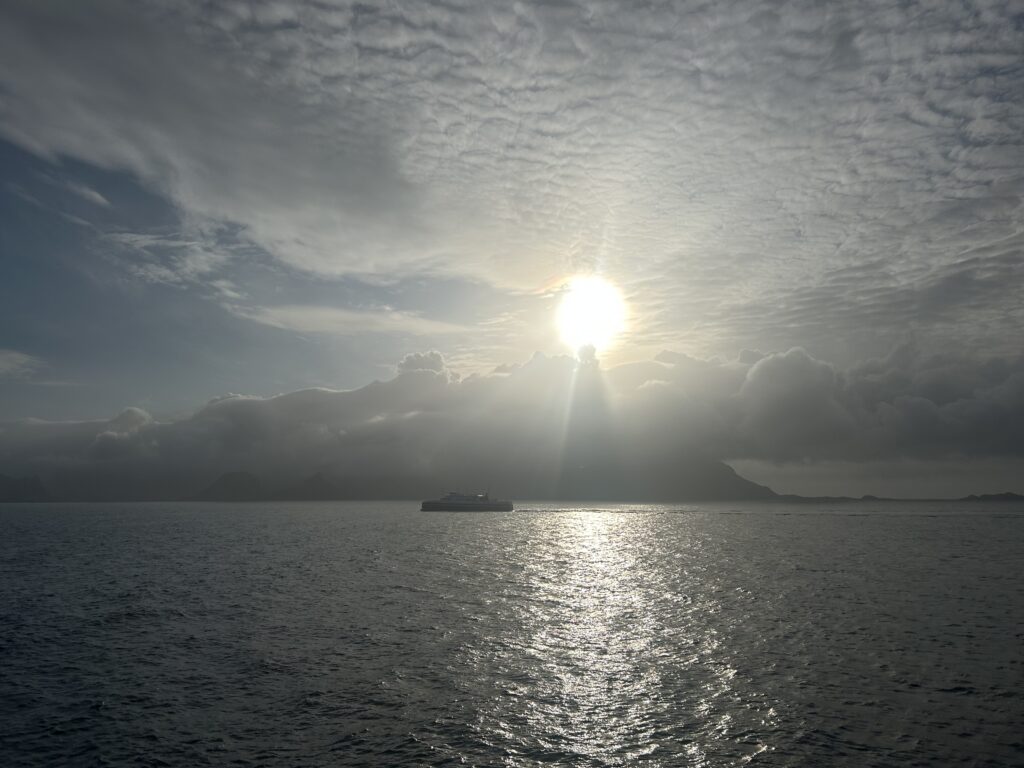
I arrived at Rost around midnight, considering I have been awake since 03:00 I’m starting to get somewhat tired. Before arriving to Rost I had scouted, using google street view, where a good place to pitch a tent might be. It seemed that the north side of the Island would be best suited and, therefore, I headed straight there. When I finally go to bed, the time is well into the next day. This is actually the last night at Rost where the sun does settle, albeit for a few minutes. From here on, I will have midnight sun for the rest of my stay.
A lot of traveling this day. Luckily I had purchased the book Chip War before I departed. A superb and well-written story about the history and trends in semiconductor manufacturing. Highly recommended if one is interested in understanding why the business looks like it does. One copy can be found at Rosts book booth.
2025-05-29, Thursday – Exploring Rost
A proper sleep-in this morning. The goal of the day is to explore all of Rost whilst doing some bird spotting. It is an extremely windy day, with occasional showers of rain. With my heavy and large backpack, almost serving as a sail, it is sometimes challenging to keep my balance.
Rost is a bird’s paradise, they are literally everywhere. I spot a great variety of birds – such as Grey heron, oyster-catcher, Eurasian curlew, Skuas, and many more – but no puffins. A large part of Rost is developed land, and the parts that are undeveloped is mostly marshland. I for sure scouted the best place to pitch my tent (thank you google street view), most other places would have proven difficult. It is also very clear that Rost’s economy is based on fishing. There are several fish-processing industries, almost everyone seems to have their own little fishing boat in combination with large scale fishing boats, and there are Stockfish – a type of dried fish, not to be confused with the chess-engine – hanging everywhere. In fact the entire Island reeks of a fishy smell, and after a while so do you.
According to some of the locals, Rost exports Stockfish for 50 million Euros each year. Most of it is exported to Italy. The reason is that in Italy they want the highest quality food product. Rost Stockfish is of the highest quality because of the relatively stable climate (temperature), giving the Stockfish a long time to dry. In other parts of Lofoten it is warmer in the summer and colder in the winter, shortening the drying time. The longer the Stockfish dries, the higher the quality.
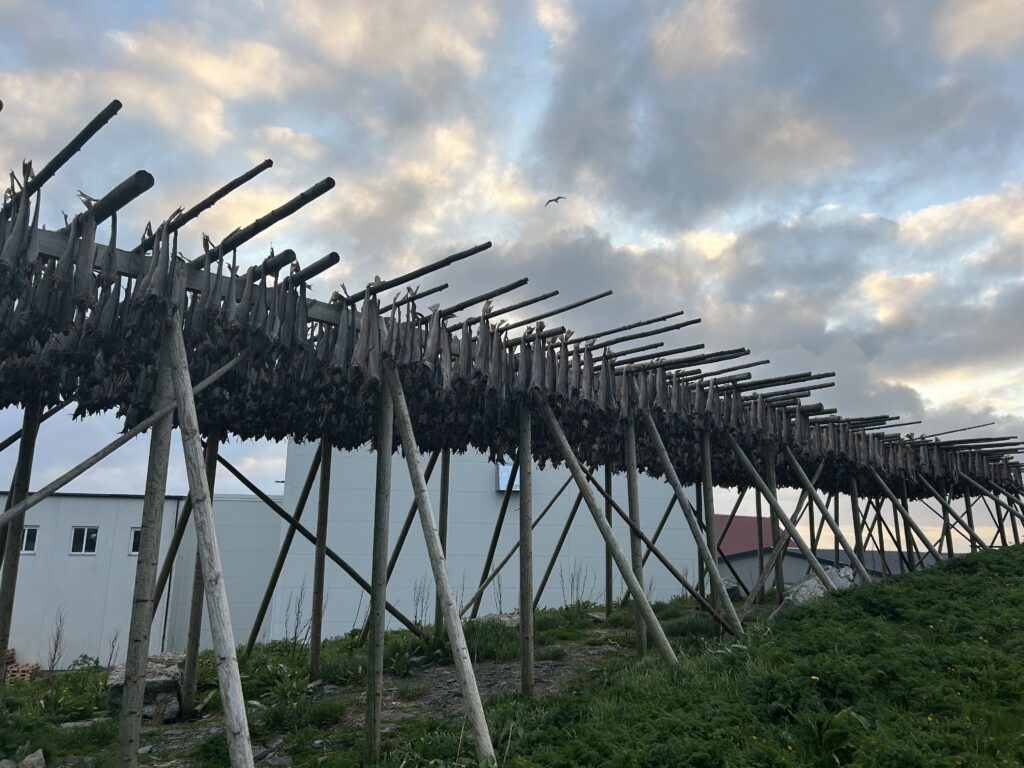
Stockfish quality is not the only reason Rost has strong ties with Italy. Based on stories from the locals, the connection to Italy goes back to the 15th century. A group of Italian sailors, after getting hopelessly lost at sea, got stranded at one of Rost’s neighboring Islands. Eventually the 11 survivors, out of 66 sailors, were rescued by the inhabitants of Rost. Friendships were formed and the survivors brought Stockfish to Italy.
In the eastern part of the Rost there is a type of archipelago which is uninhabited and much larger than one expects. However, one has to be careful. Many of the Islands are only accessible at low tides, and the difference in water level between high tide and low tide is about 2 meters. Other than the archipelago, Rost is not that great of an Island to visit. As said, the Island is either developed land or marshland. Still it is awesome to be out far into the ocean with water as far as the eye can see in all directions – Norway truly does have a living countryside. After circling the Island I’m back where I started. Time to prepare for another night! I believe I climbed the 11 meter peak, but honestly that is not very clear.
Considering I struck out on spotting the Puffin, that evening I decided to book a boat Puffin safari for the following day.
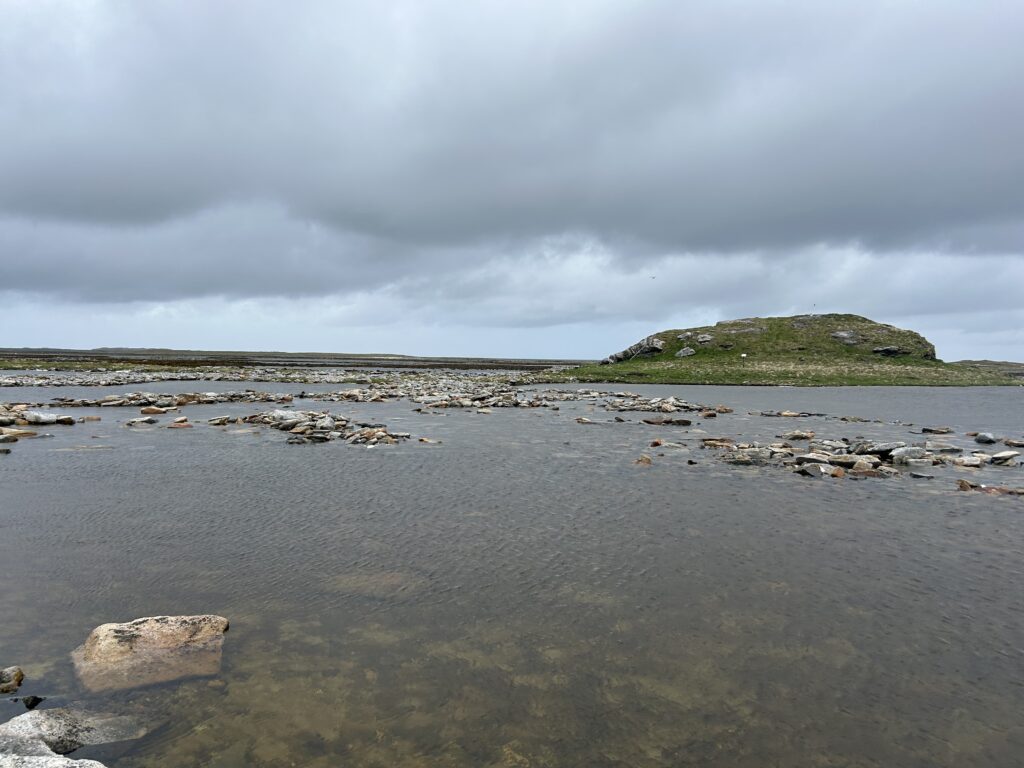
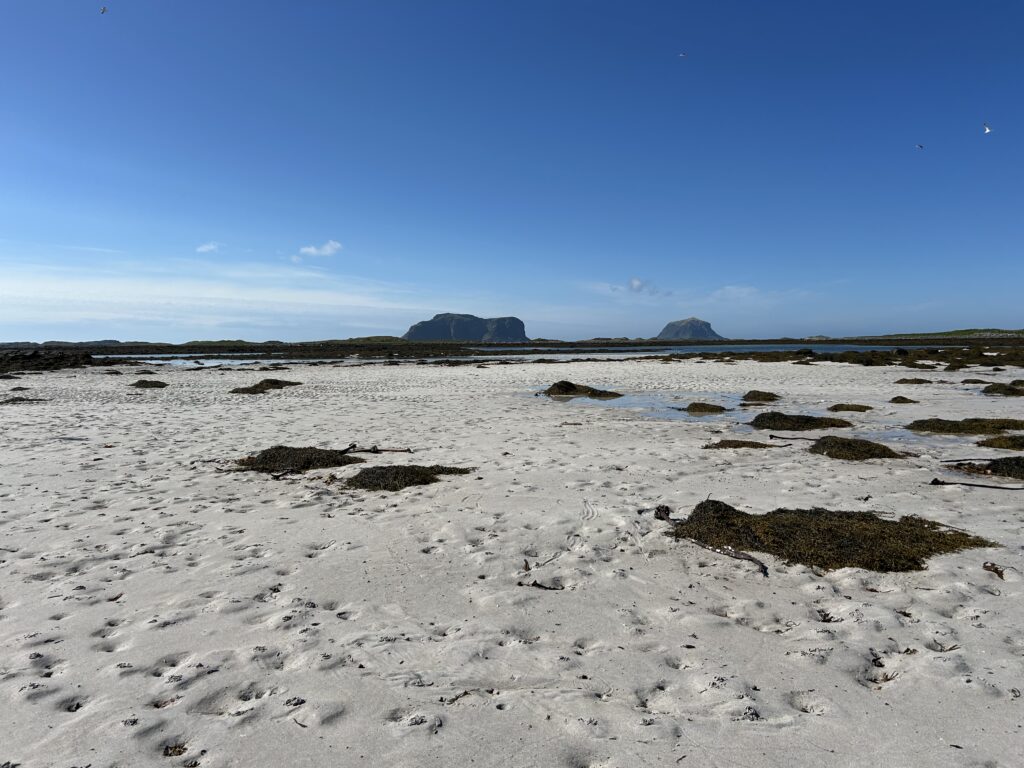
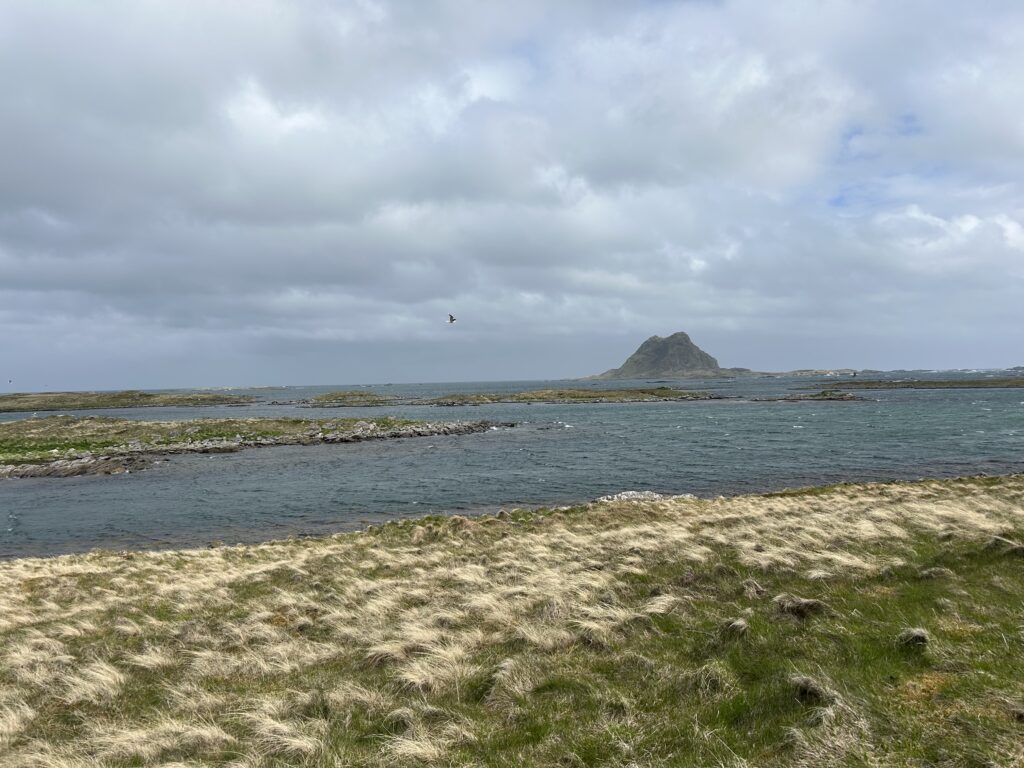
2025-05-30, Friday – Puffin Safari
My scheduled boat safari is not until 13:30 so I spend some time playing around in the archipelago. This time I was there when the low-tide was at a minimum, and the archipelago sure does feel larger now. As already described, Rost is a densely inhabited Island, with no vegetation or elevation difference, and there is not a single public restroom!
While exploring, I’m attacked by two Skuas, chasing me for at least a kilometer. Skuas seem to be an extremely aggressive species. From afar I constantly see them attacking the other birds.
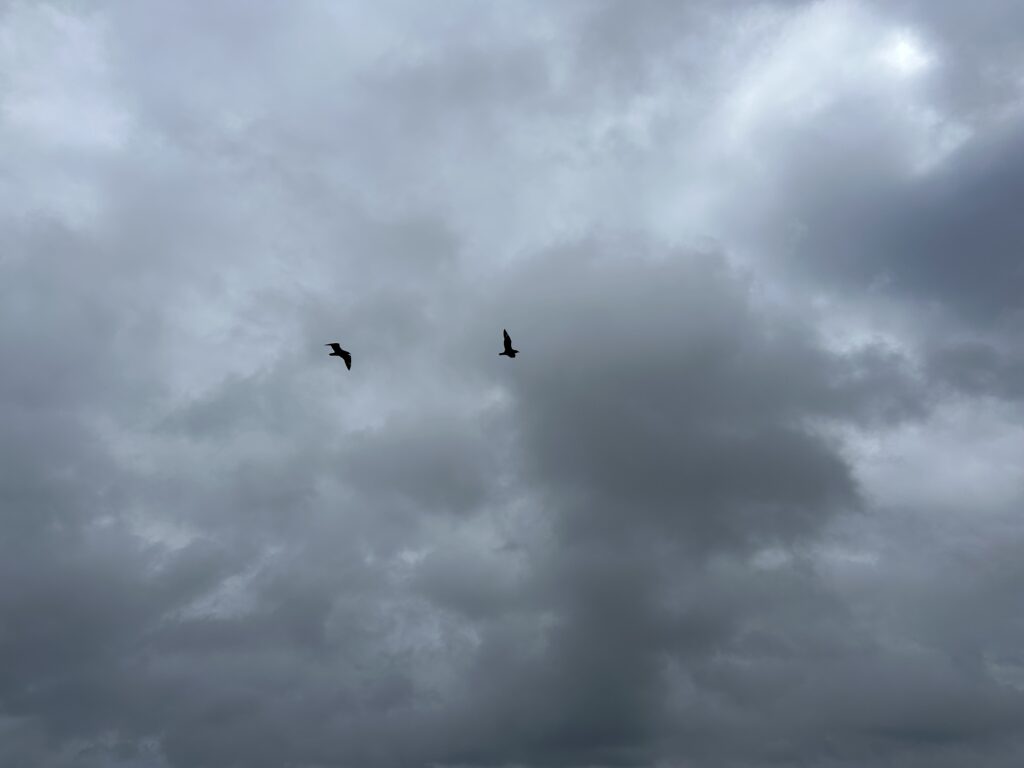
During the boat tour it does not take long before I finally get to spot loads of Puffins. I have wanted to see Puffins since my interest in bird spotting started at around 13-years of age, and now I finally get to do it. I’m almost emotional. There are also many other birds (loads of sea eagles) and one gets a proper view of the surrounding Islands. To top it all, the tour guide is an excellent storyteller.
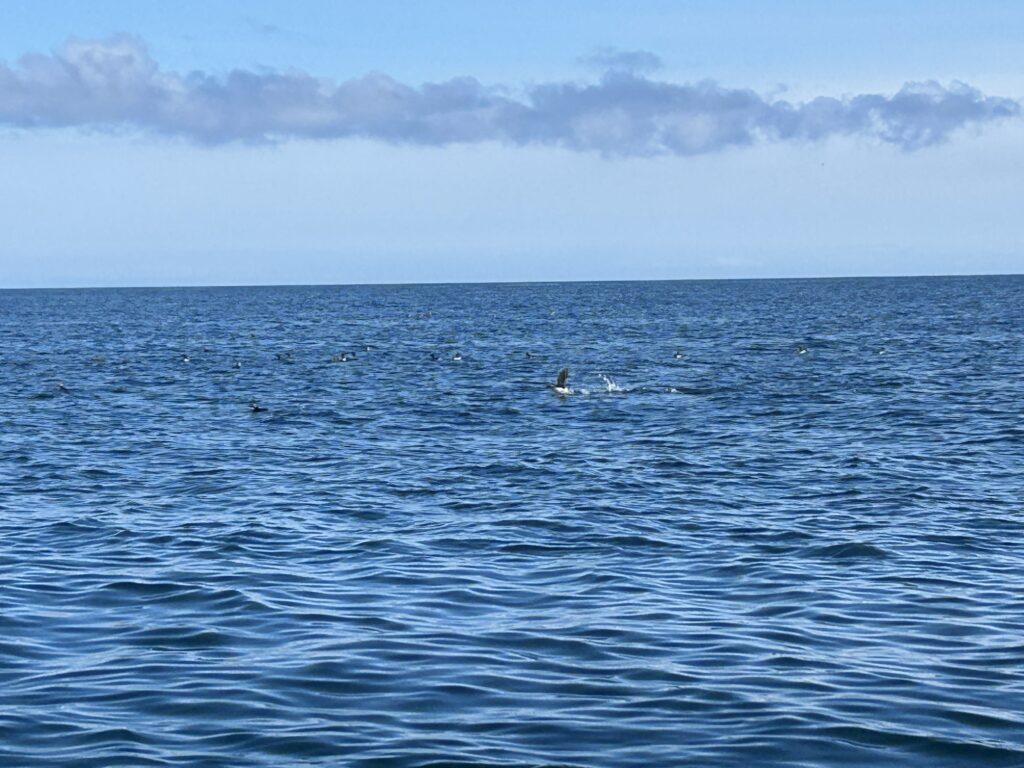
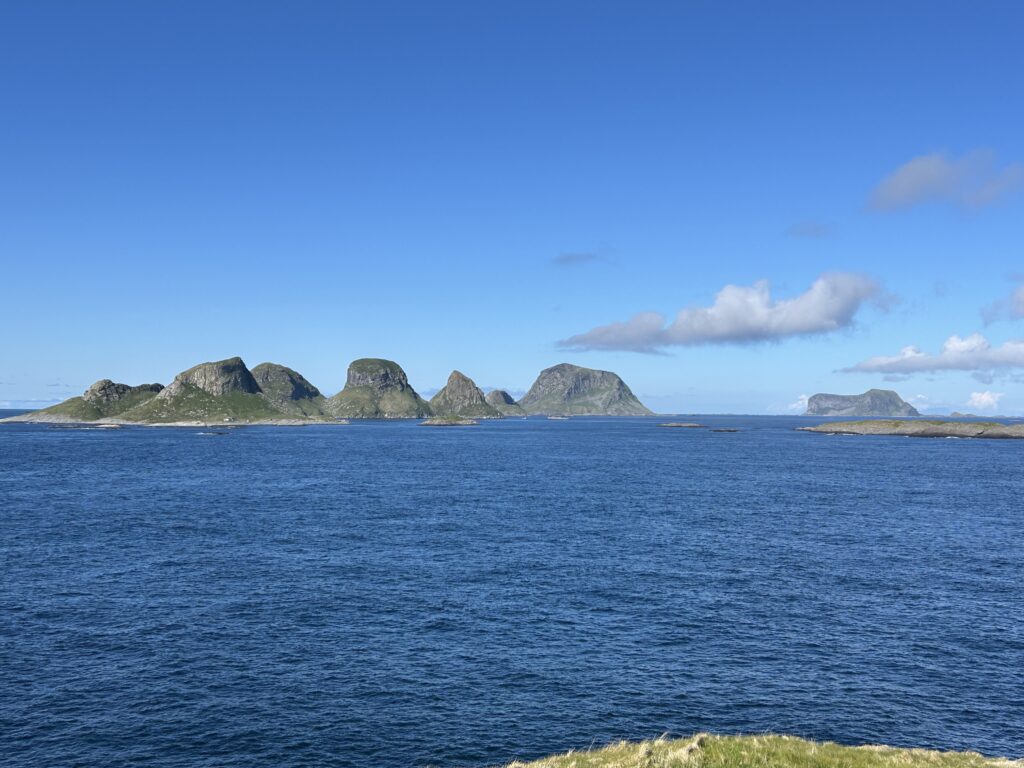
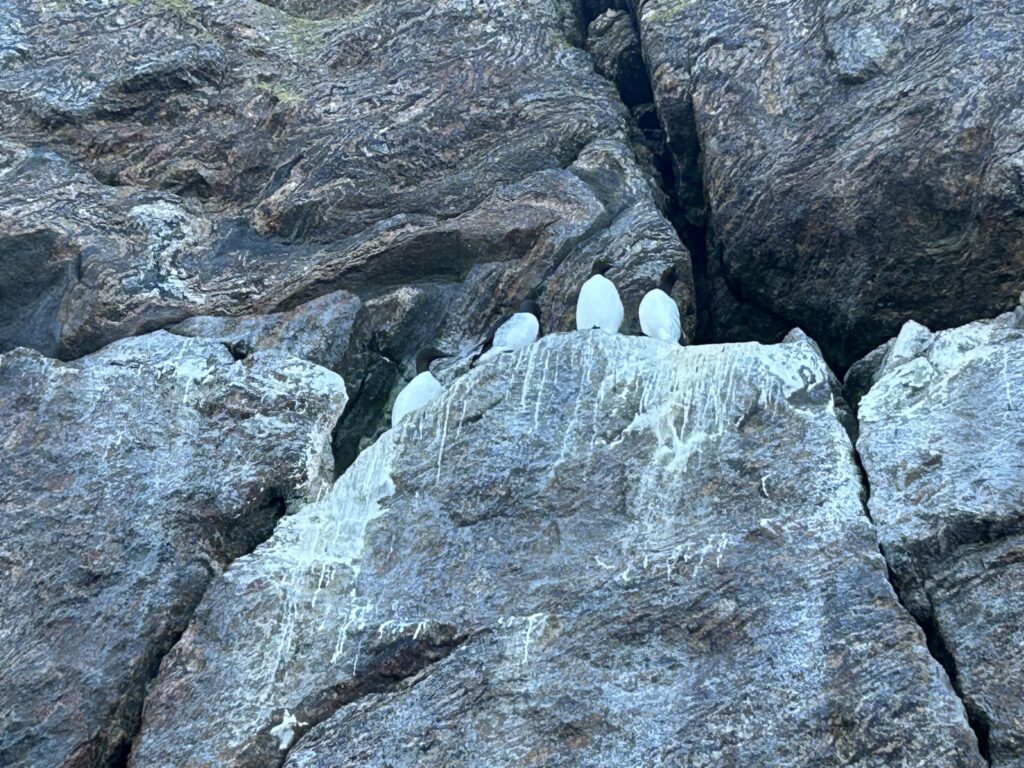
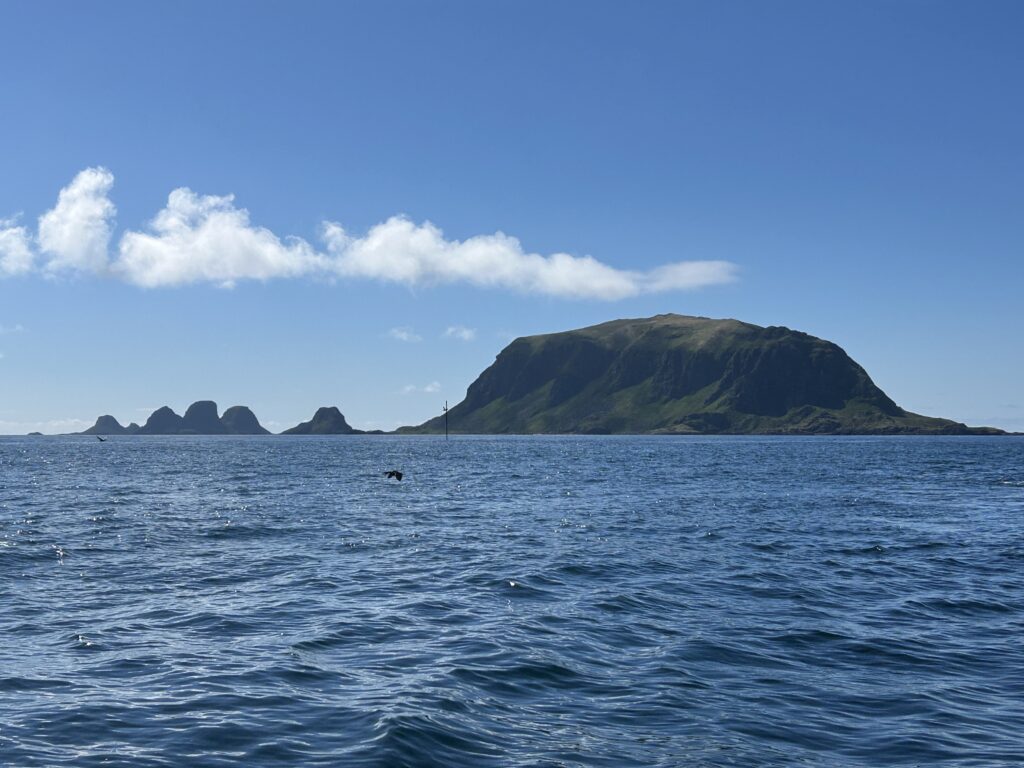
One of the more interesting stories is about how a Swiss scientist came to the area in 1969 and settled at one of the remote Islands during the summer. That year, all the pufflings (Puffin babies) died, which he of course thought to be strange. He went back to Rost and interviewed the locals whether this phenomena had happened before, and sure enough similar events had occurred before although they were very rare, like once in a generation. He went back the following year to study the puffins, but once again all the pufflings died. Next year, same story. Next year again, same story. What is going on? This is for sure not normal.
He found a journal from the Faroe Islands which had detailed accounts, going back to the 14th century, of how many Puffin feathers that were exported each year. Every 250 years there was a large decline in sales for a few years, and according to data the cyclic decline coincided with the current time period. The reason turned out to be that every 250 years cold water from Greenland is pressed towards the Norwegian coast which kills the young herrings, the Pufflings’ primary source of food. The reason that all the pufflings died was thus due to cyclic natural events and the Swiss scientist concluded that the pufflings survival rate should go back to normal in a few years. But it did not!
The problem with the pufflings not rebounding was that in the 1970s and 1980s the commercial fishing industry had become increasingly effective, resulting in a strong decline in the Herring population in the Barrent sea, especially as there was no influx of new herring since they all ended up dying. The remaining Herring population was not big enough to lay enough eggs for the pufflings to feed, so the pufflings continued dying. It took many years before a successful season occurred, and the population has continually struggled since 1969 with the result that the Puffin population has declined significantly. It is believed that adult puffins, in the wild, can live to roughly 70 years old and that is the only reason that Puffins still exist.
However, it is not all pitch black. Last season (2024) was an extremely successful season, with an estimated 100 000 pufflings surviving. Based on this season alone, the population will probably increase slightly over the coming years – The pufflings spend 5-7 years on the open sea before returning to land to nest and lay eggs. There is for sure some light at the end of the tunnel.
Disclaimer, I do not guarantee that my recount of this story is 100 % factually correct. I’m retelling the story from how I remember it.
Amazing day at sea. I give the tour a 10/10. If going to Rost be sure to check out Day @ Sea. After the tour it is time to move on to Vaeroy. I spent two days here and, frankly, that is enough. The Puffin safari was the main reason for coming. Both times I have arrived in Vaeroy, the mountain has been covered in deep grey clouds. Bad omen? Upon arriving in Vaeroy I walk to Brevika, pitch my tent, and fall deep into sleep at the sound of the ocean waves.
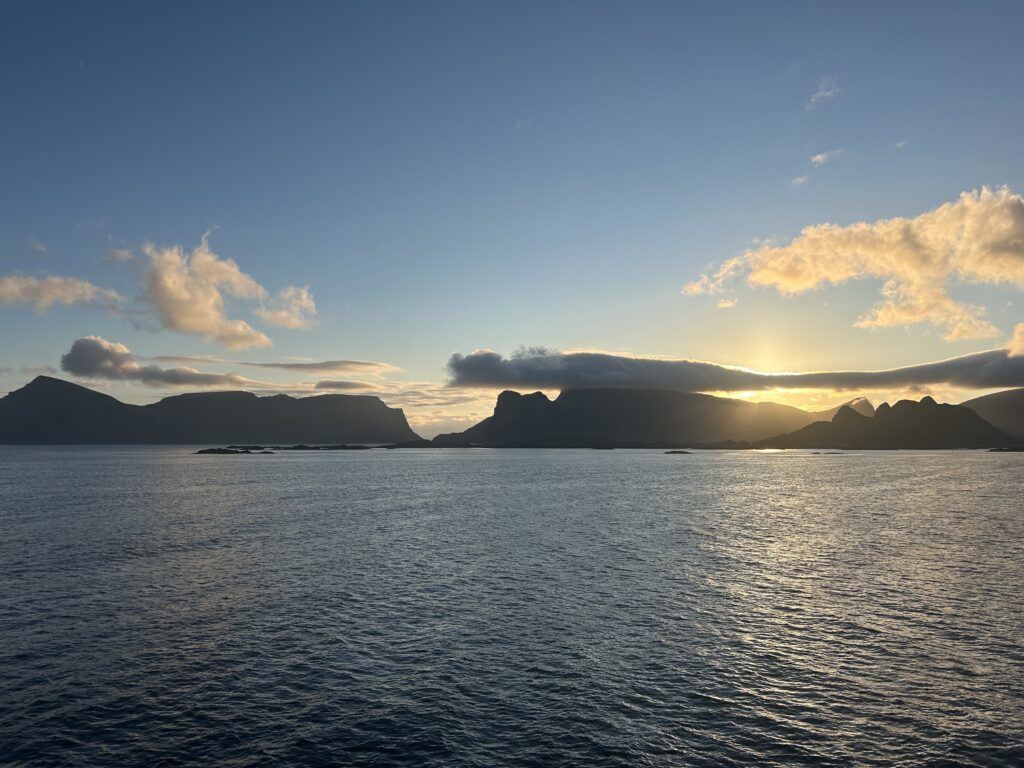
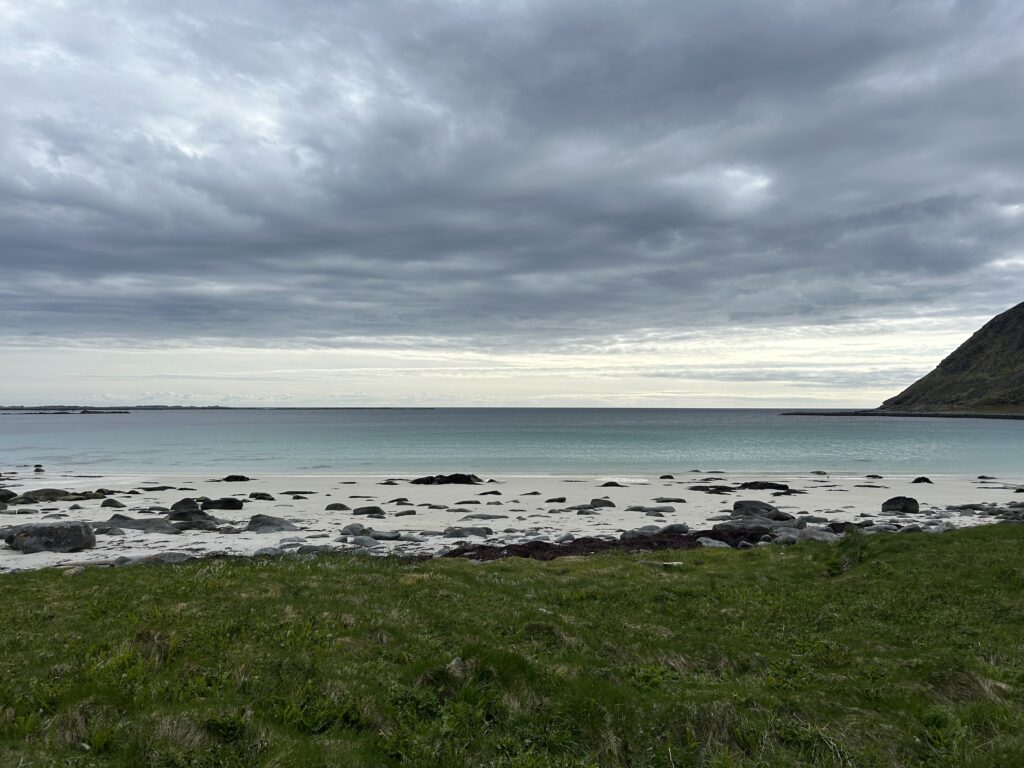
2025-05-31, Saturday – Vaeroy Part 1
First order of business is to resupply, leaving my tent and my gear I take a walk back into town to purchase some well needed food. Second order of business is to climb the peak Hornet. While hiking up Hornet I meet a Norwegian and stop for a quick chat. He goes on about how much he loves nature and everything that is wrong with modern society that disconnects us from our natural habitat. “We were created to live in the outdoors” – Hear Hear, preaching to the choir.
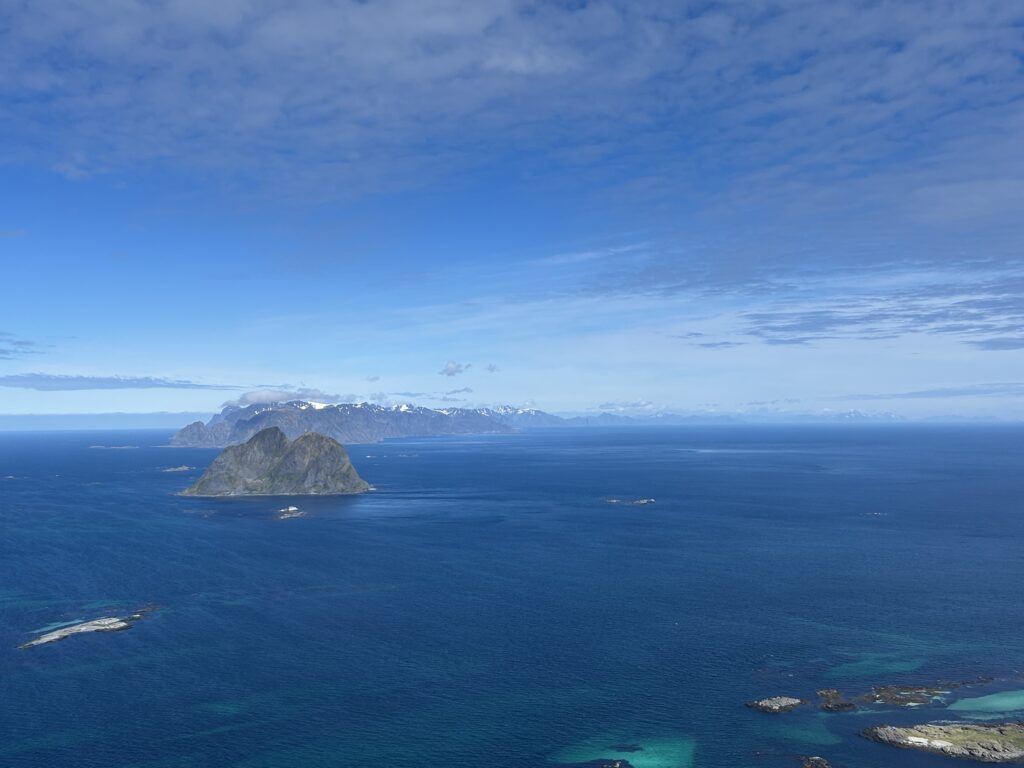
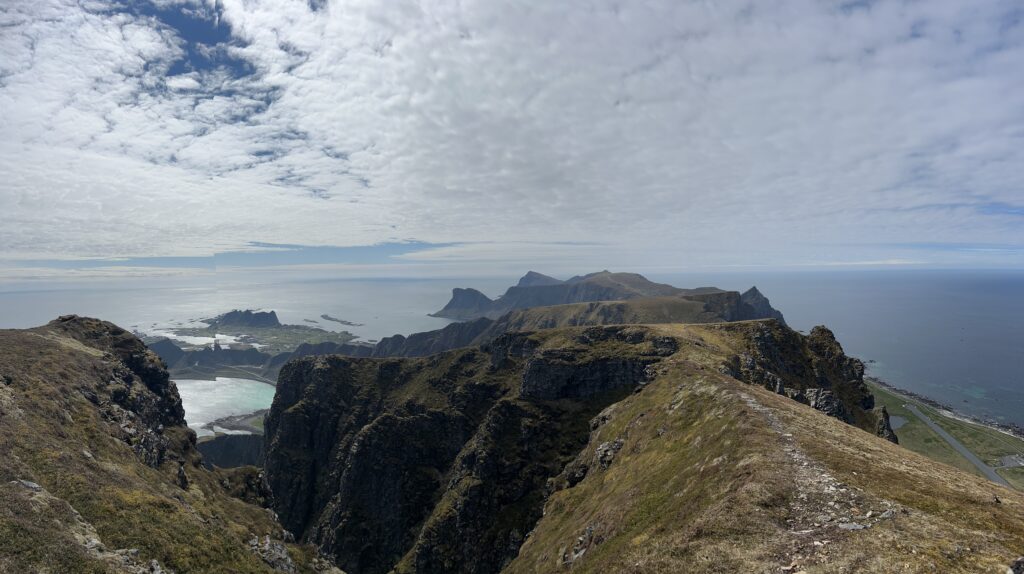
I spend the rest of the day climbing all the peaks and roaming around the northern part of Vaeroy. Norlandshagen, a somewhat sheltered beach with pristine clear water, makes for the perfect campsite. If not for the exceptionally strong winds, I would definitely have gone for a swim or perhaps one should say dip considering the water temperature.
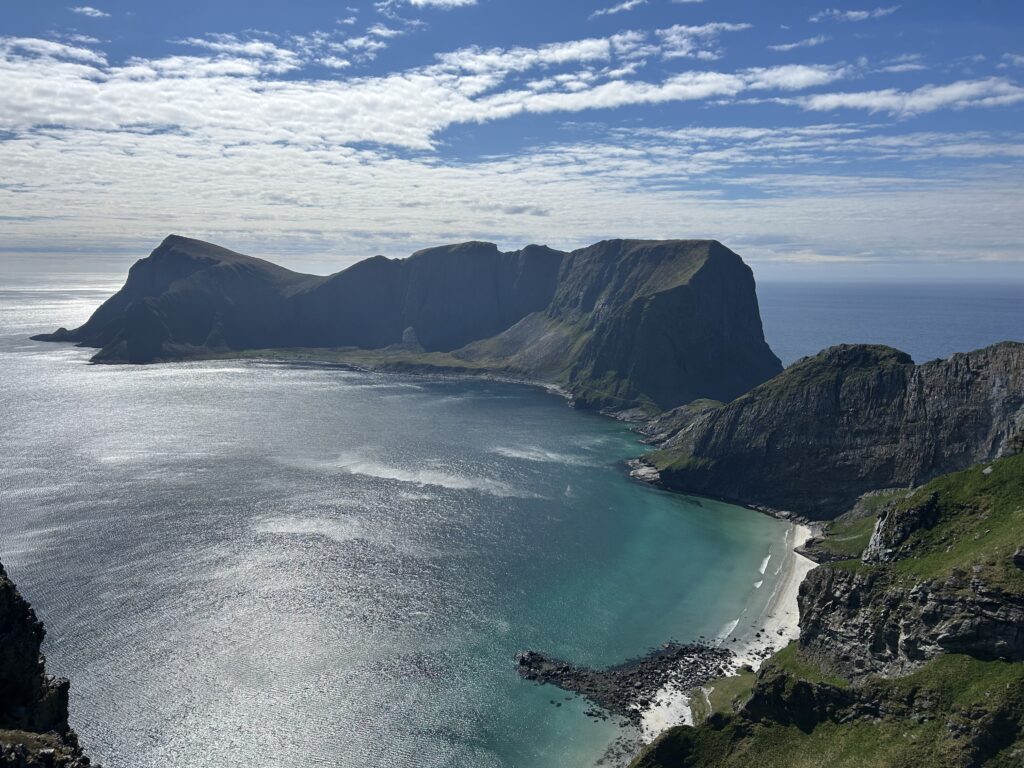
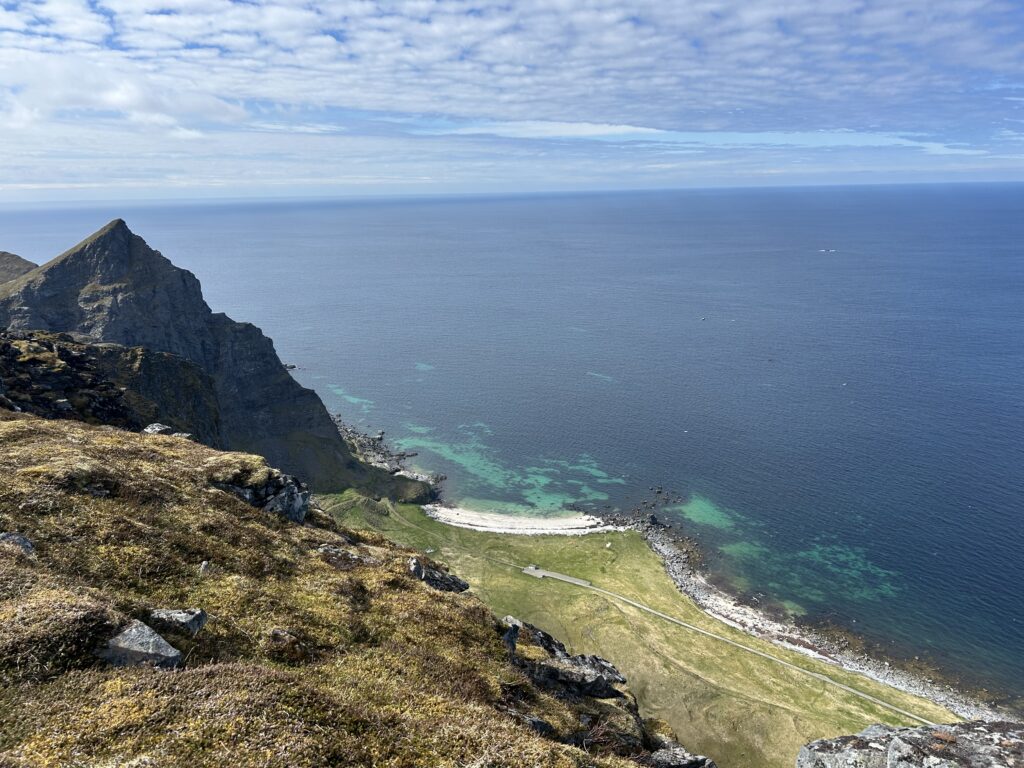
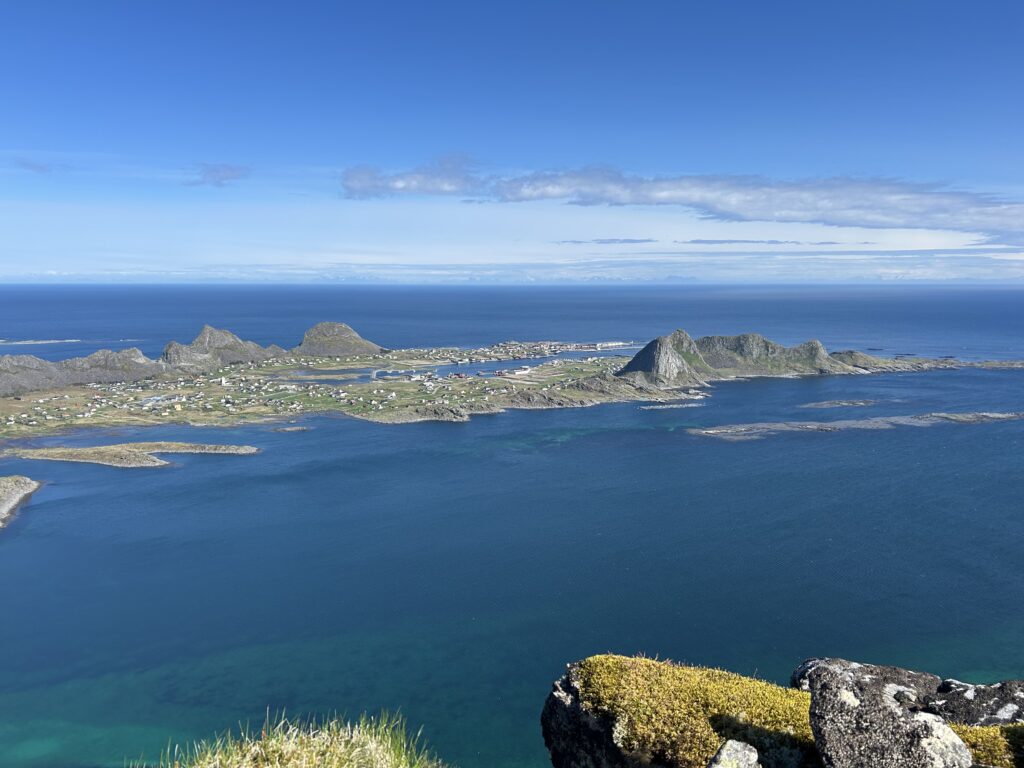
2025-06-01, Sunday – Vaeroy Part 2
Upon awakening I head for Måstad. Måstad is a small former town at the southern part of Vaeroy. The path to Måstad is surprisingly twisty and rocky. I saw the path from afar yesterday from the mountain peaks, it then looked fairly easy. Looks can be deceiving. Seeing what is left of the small town it is hard to imagine that 100 years ago over 100 people lived here, surviving on sheep herding, fishing and catching puffins and puffin eggs. Now there no longer are any permanent residents living here, only some summer residents.
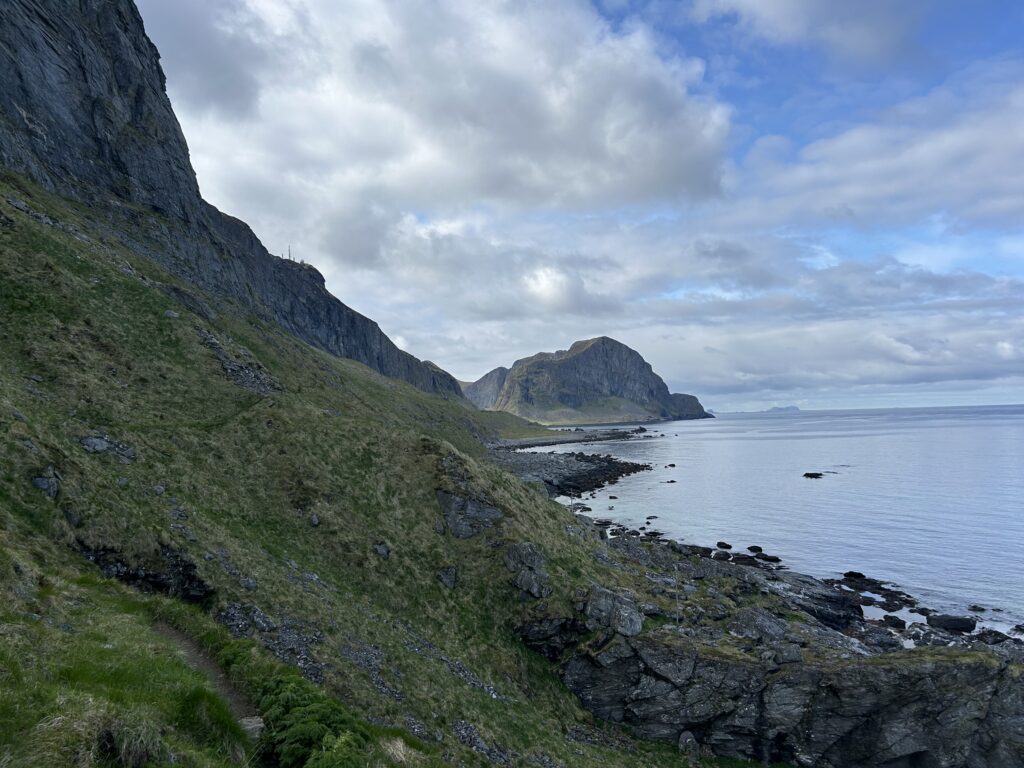
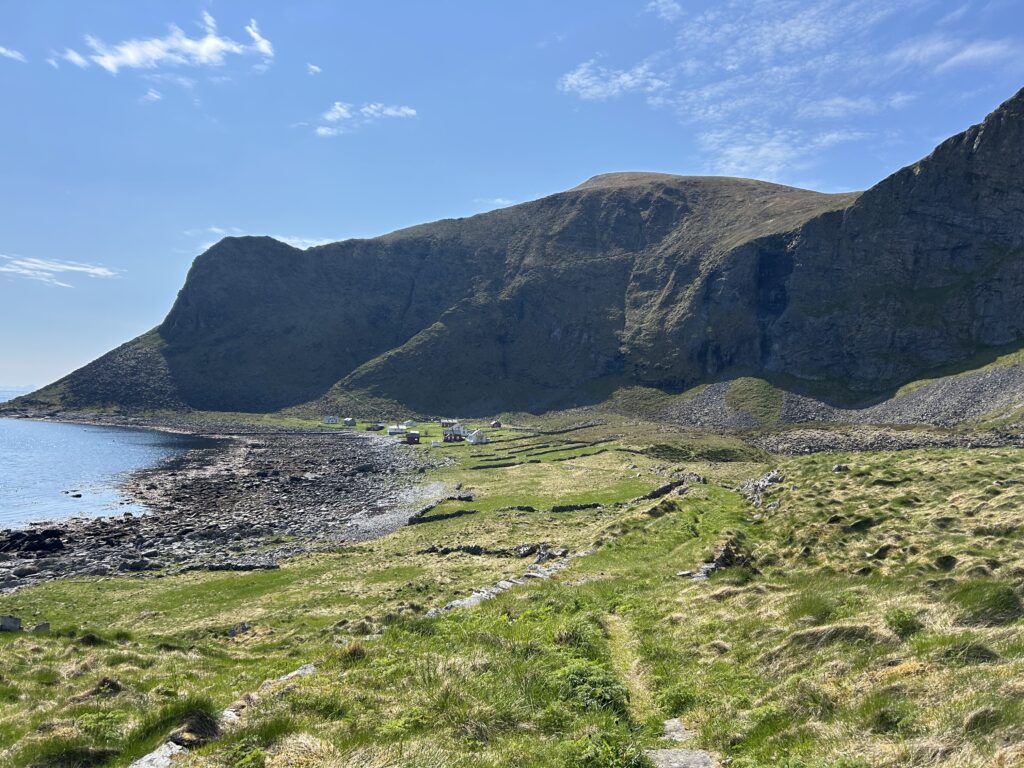
I leave my backpack in town to climb the surrounding mountain peaks at Måstadsfjället. While I was gone, some bird, probably a seagull, took a massive sh*t on my backpack. Luckily before leaving I put the raincover on in case the weather would change. The weather did not change but remained sunny, the raincover cover instead served another purpose. I spent another night at Norlandshagen. At this point I regret not taking two books with me. Would have been nice to have something to read at the end of the day.
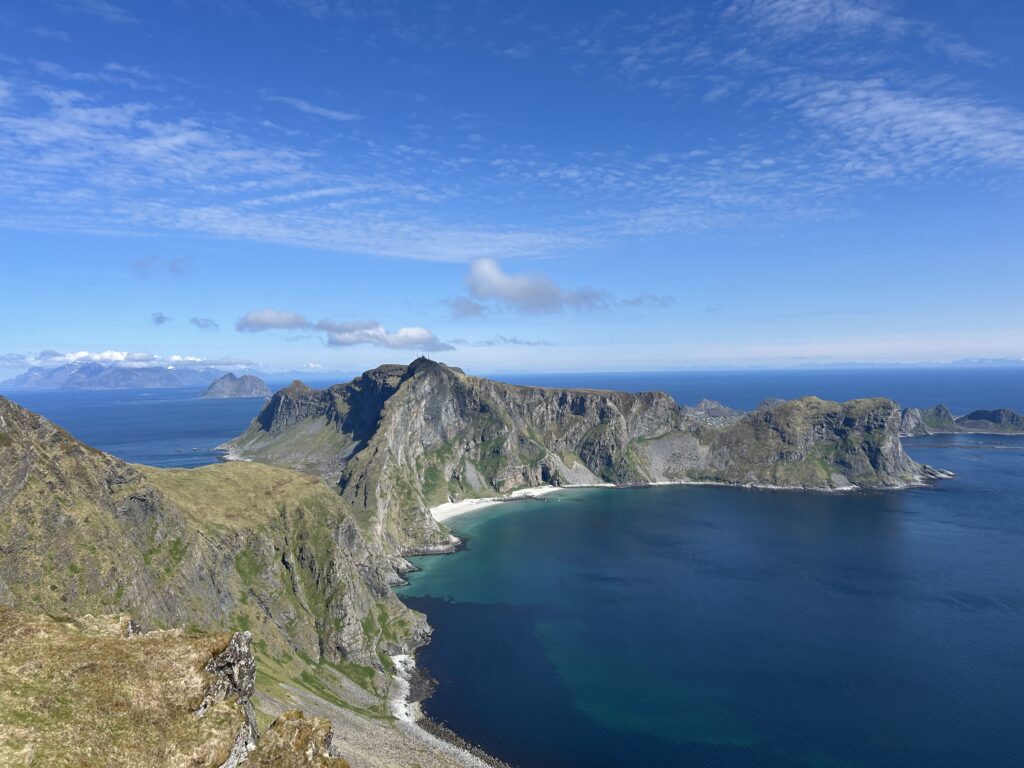
2025-06-02, Monday – Vaeroy Part 3
Last day at Vaeroy before the ferry leaves for Lofoten (Moskenes) tomorrow morning. A relatively slow and easy day, I have already seen everything I wanted to see. I spend the day mostly walking around, going to a few new places. This night I instead spent at Sörlandshagen. Norlandshagen is for sure a better campsite.
Vaeroy is a much more spectacular and fun Island than Rost, and it is well worth a visit.
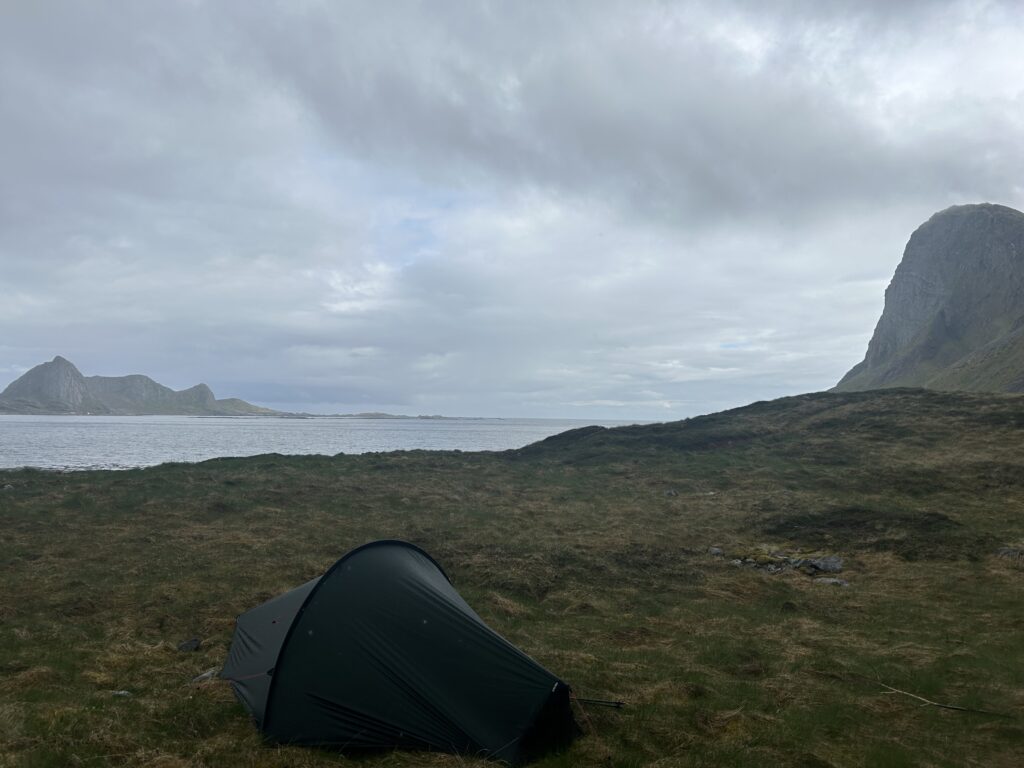
2025-06-03, Tuesday – Conquering Hermannsdalstinden
Early start of the day to catch the ferry heading to Moskenes. All the peaks surrounding Moskenes are covered in snow, and from the ferry I see plenty of small streams, or small waterfalls one might say, after all, the mountains are steep. Anyways, finding water will not be an issue and I reckon that I will not have to carry any water. As it turned out, I was correct in my assumption.
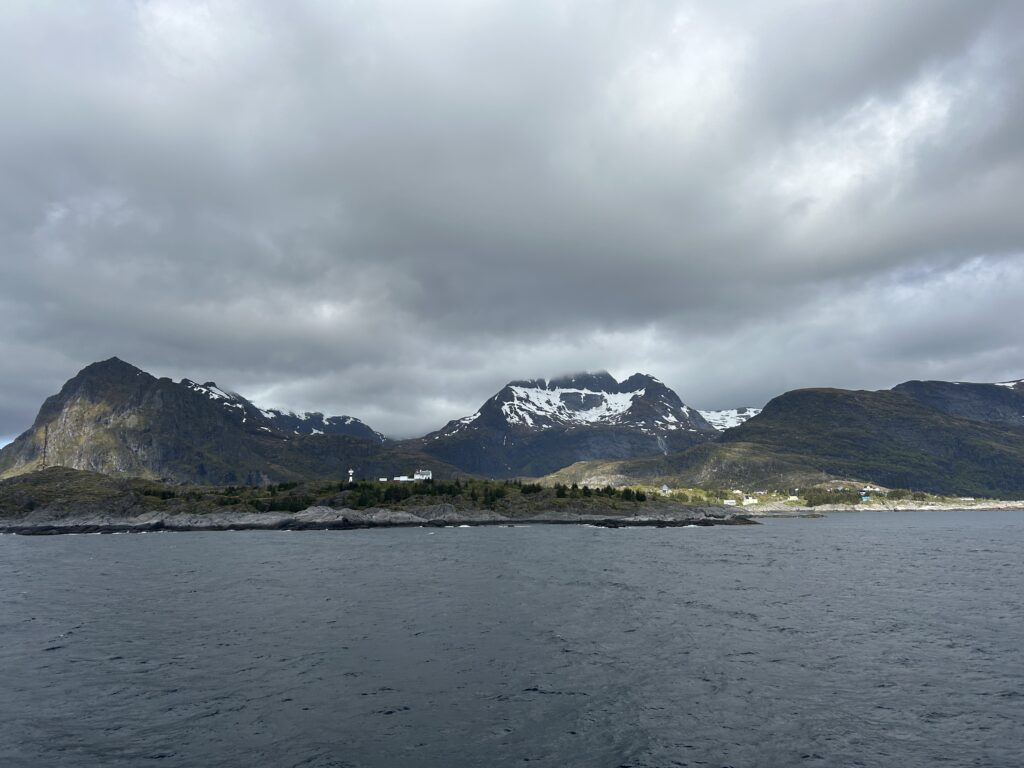
The plan is to climb Hermannsdalstinden to then continue onward to Vindstad and Bunes beach where I will camp for the night. Hermanndalstinden was not an easy climb. The peak is 1013 to 1029 meters (it varies between sources) above sea level, and I’m basically starting at sea level. However the route is very hilly so the total climb is close to 1700 meters. In addition, the route is muddy – one wrong step and you will slide down the hill – and snowy. Already at about 350 meters of elevation there are thick snow patches, and this has me slightly worried for the situation at higher elevations. I’m not equipped for prolonged snow hiking.
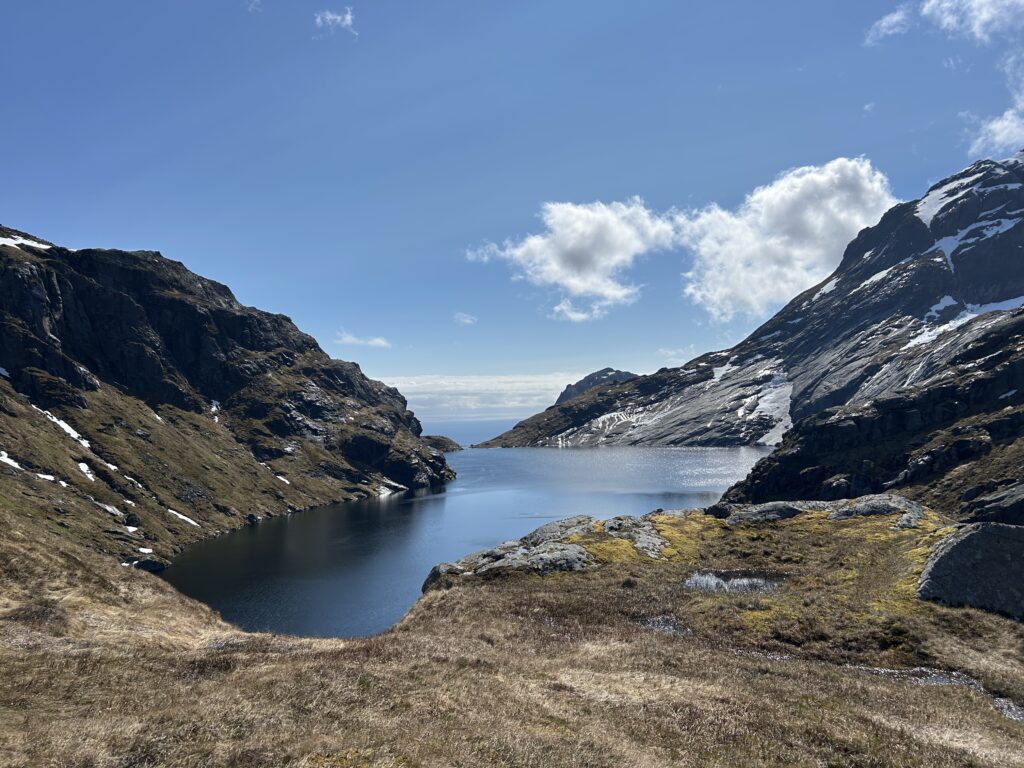
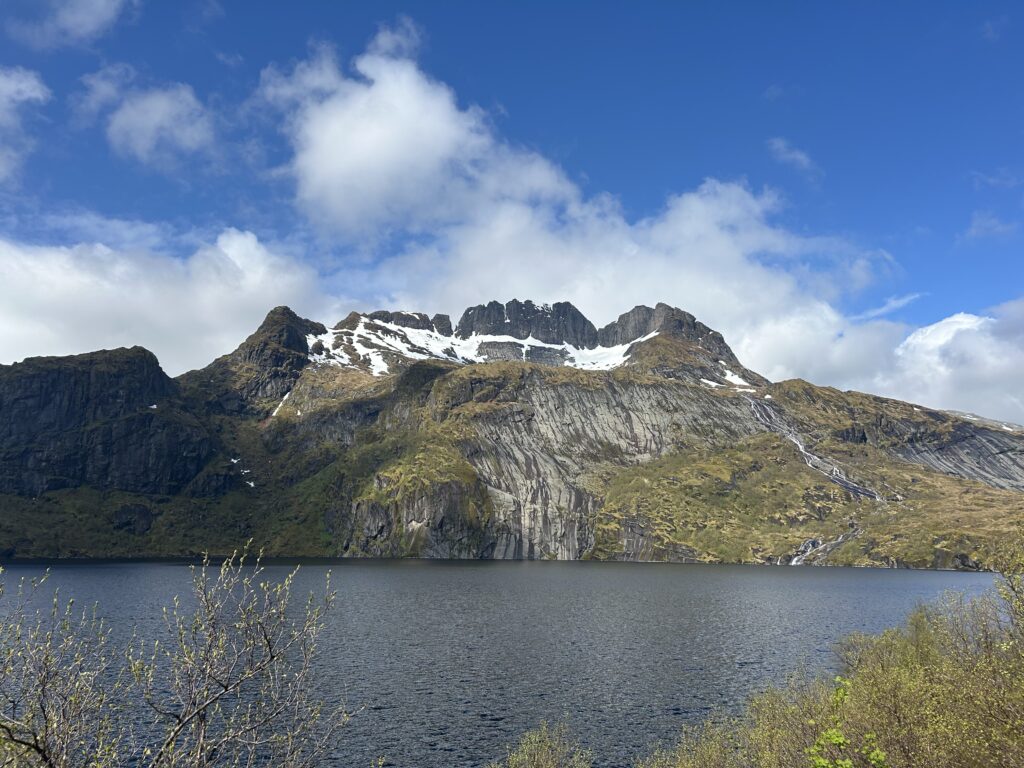
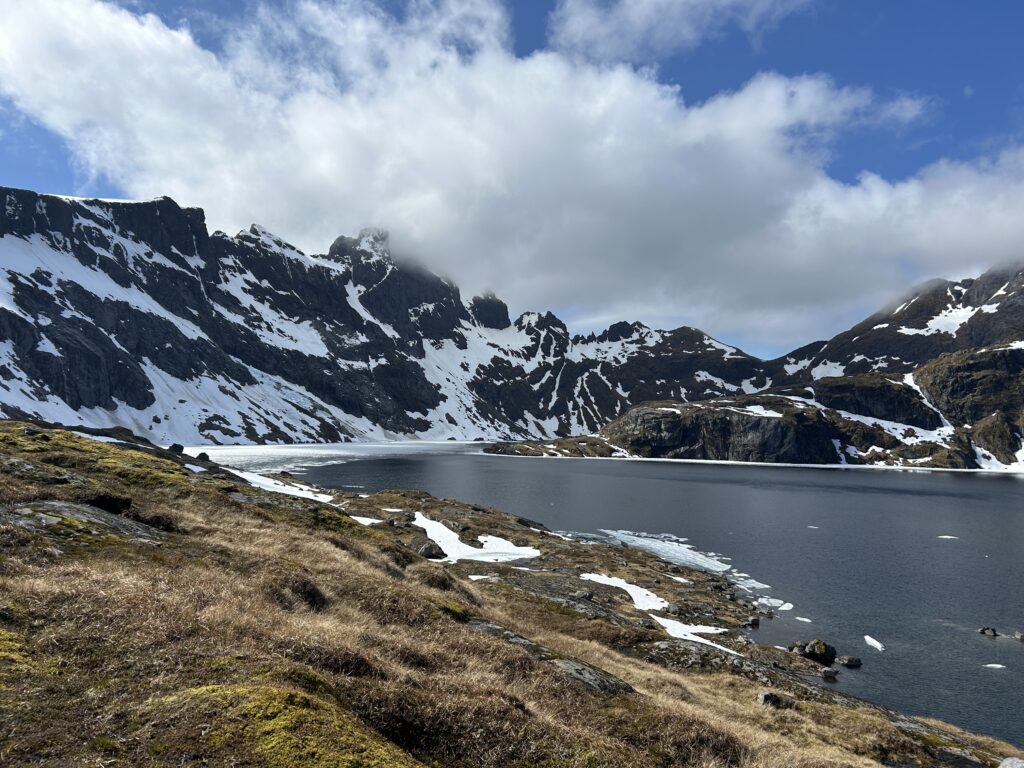
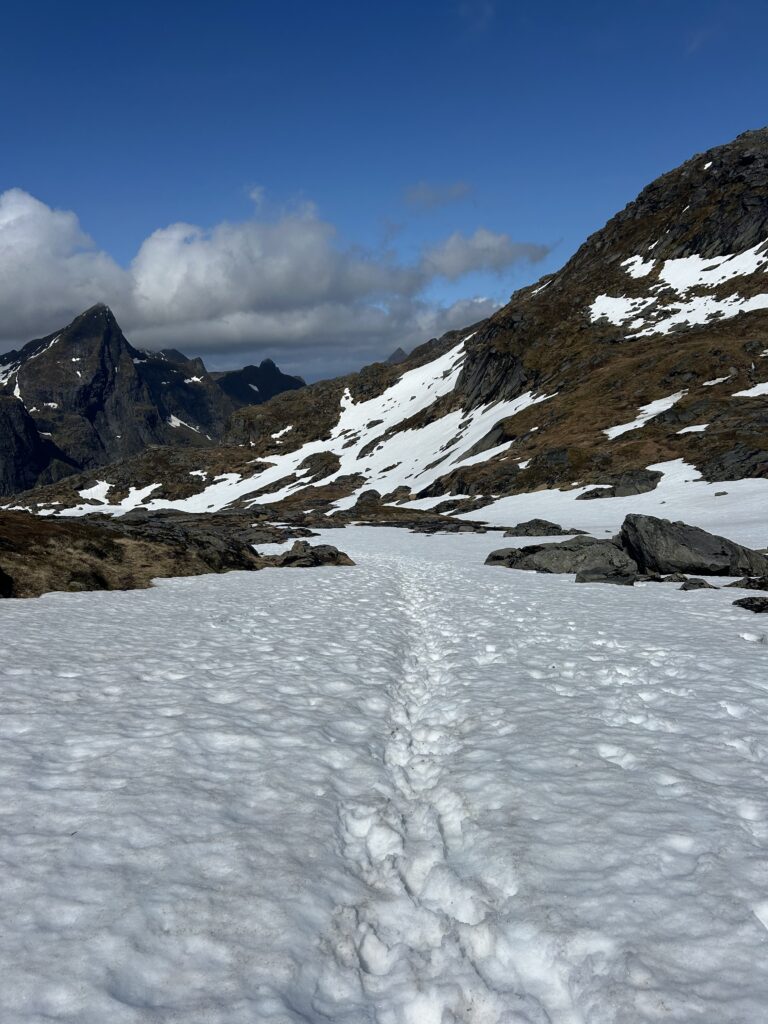
There are plenty of other hikers around, but almost everyone seems to stop at the DNT hut Munkebo. From Munkebo I get a clear view of the peak and the snow does not look to be that bad, at least from afar. Leaving Munkebo, there are no longer any visible tracks in the snow patches and I no longer see any other hikers. At the saddle point just south of Forsfjorden, I leave my backpack to make a push for the peak. Ah, the shackles are loose, time to push hard. From this point I have about 700 vertical continuous meters to go. Equipped only with my hiking poles, I push with maximum pace, trying to really get that heart pumping, something that I have been missing for the last few days.
On the way, I actually met three French guys. They had turned around because they thought the climb was too dangerous. I do not let myself get discouraged and carry on. When I have about 100 vertical meters left, I realize what they meant. The intended footpath, that would have been an easy walk in snowless condition, is covered in ice. Without crampons this is a no go. However, there is an alternative route, a ridge one can follow but that includes difficult scrambling, some free climbing, and still some patches of ice that one has to basically jump or somehow crawl across. I follow the ridge, trying to keep in mind that it is always easier to climb upwards then downwards, at least if one aims to get down in one piece. I reach a stretch that is perhaps a bit too dubious to free climb. The sensible thing to do would be to turn around. But what do I do, I pull out my phone and see that peak is just one last climb away. Ah to hell with, let’s conquer that mountain! I’m no quitter and I’m for sure not sensible. That view though, let me tell you, just wow. I guess it also looks much better after the struggle to get there.
After a moment of taking in the views, I heed back down. I managed to get back down the ridge without any major issues. Returning to the saddle point where I left my backpack, I look for the trail that will take me down to Forsfjorden and the boat ramp. My plan is to hike along the coast from the boat ramp to Vindstad, but hiking down that mud bath of a trail I see how inconvenient hiking along the coast will be – the coastline is full of mud, rock boulders, and the dreadfully dense Willow. I’m struck by a moment of weakness and start thinking: “Hm, a boat ride would be nice after all”. Luckily, I do not give in to my weak thoughts because when I arrive at the boat ramp there is a sign saying: “Boat tours no longer operated, we refer you to the footpath going to Vindstad”. You have to admire the audacity of calling that, whatever it was, for a footpath. After great length, I finally made it to Vindstad. Now there is only one last small effort to Bunes Beach, where I’m properly awarded as seen by the images.
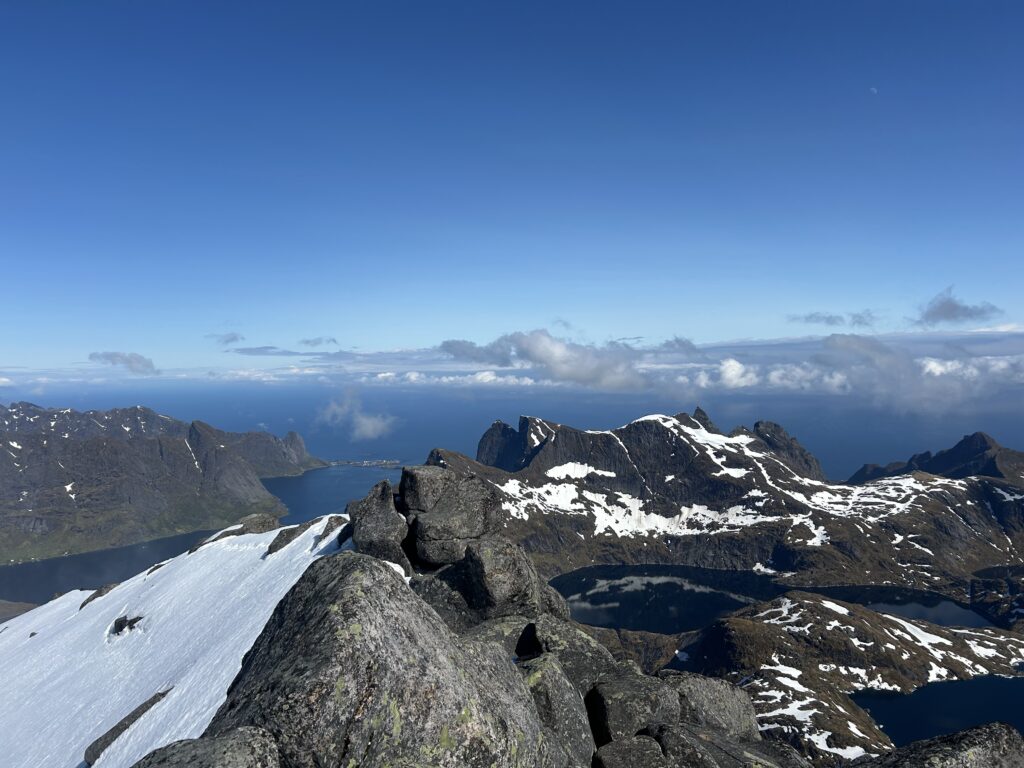
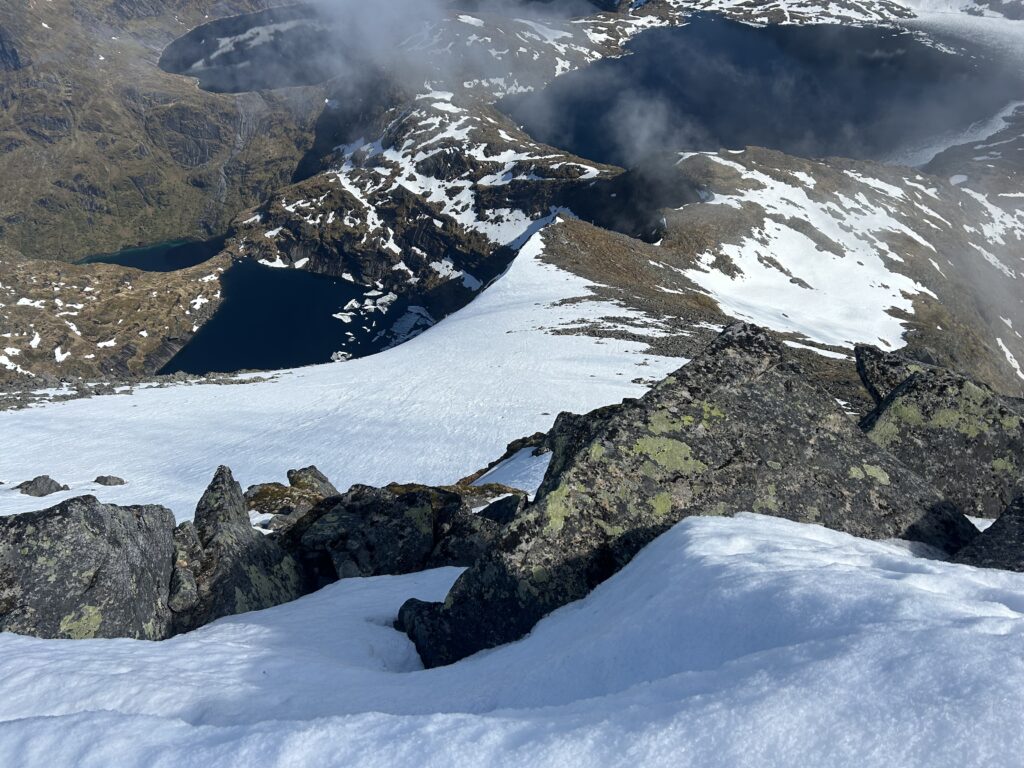
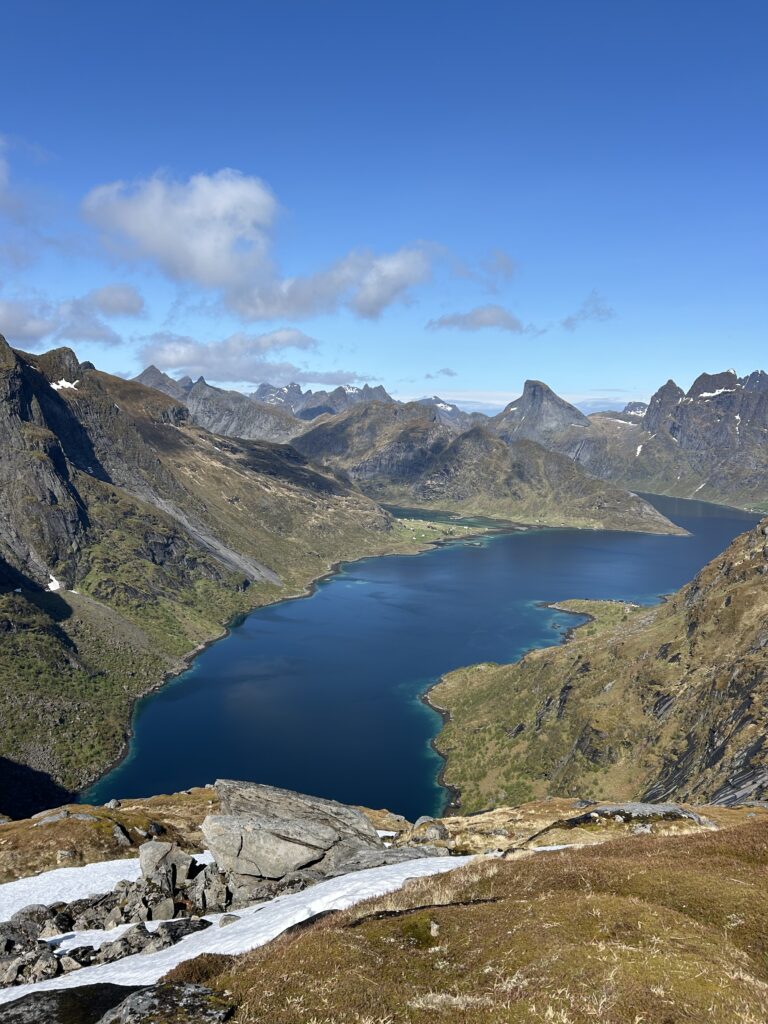
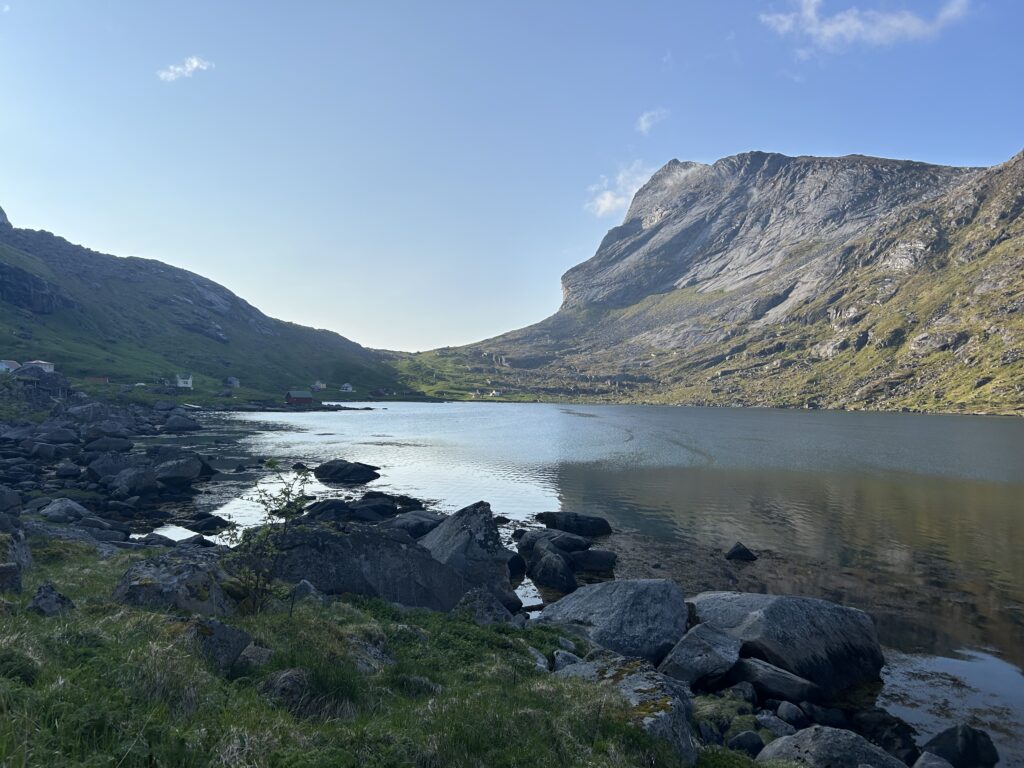
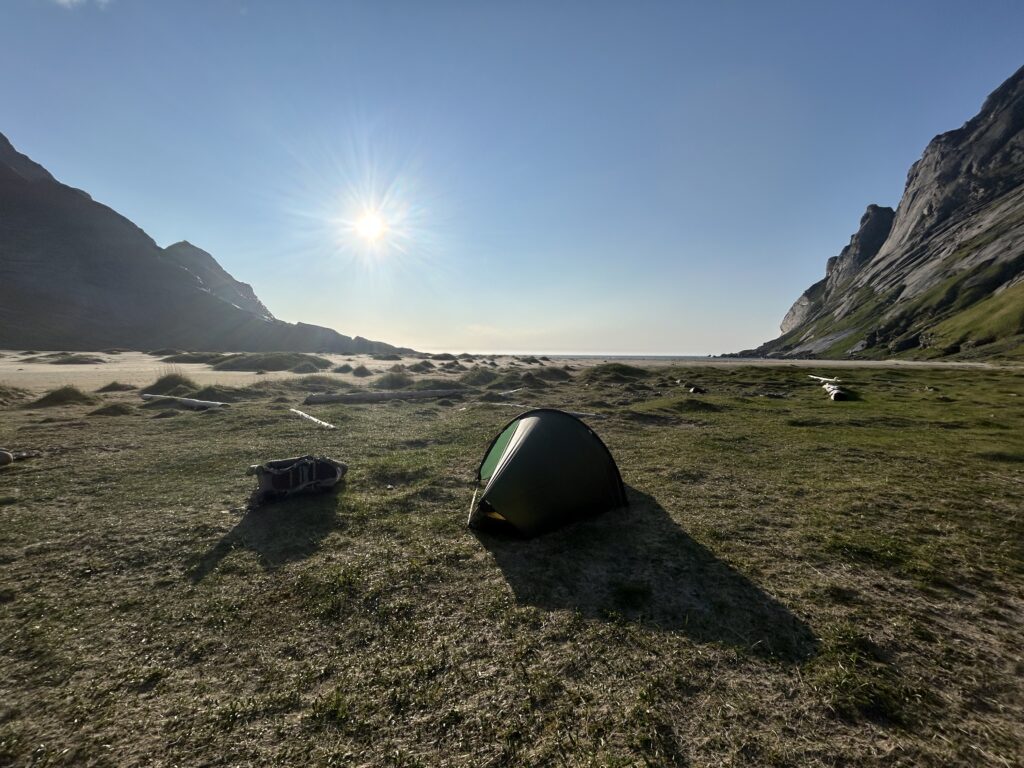
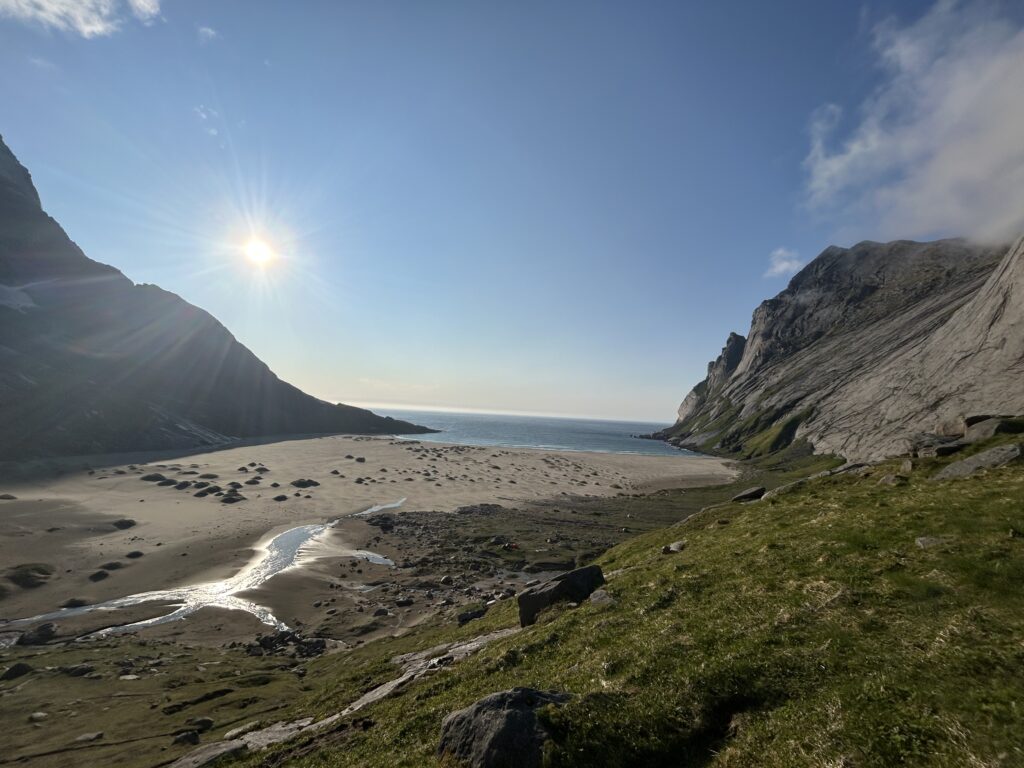
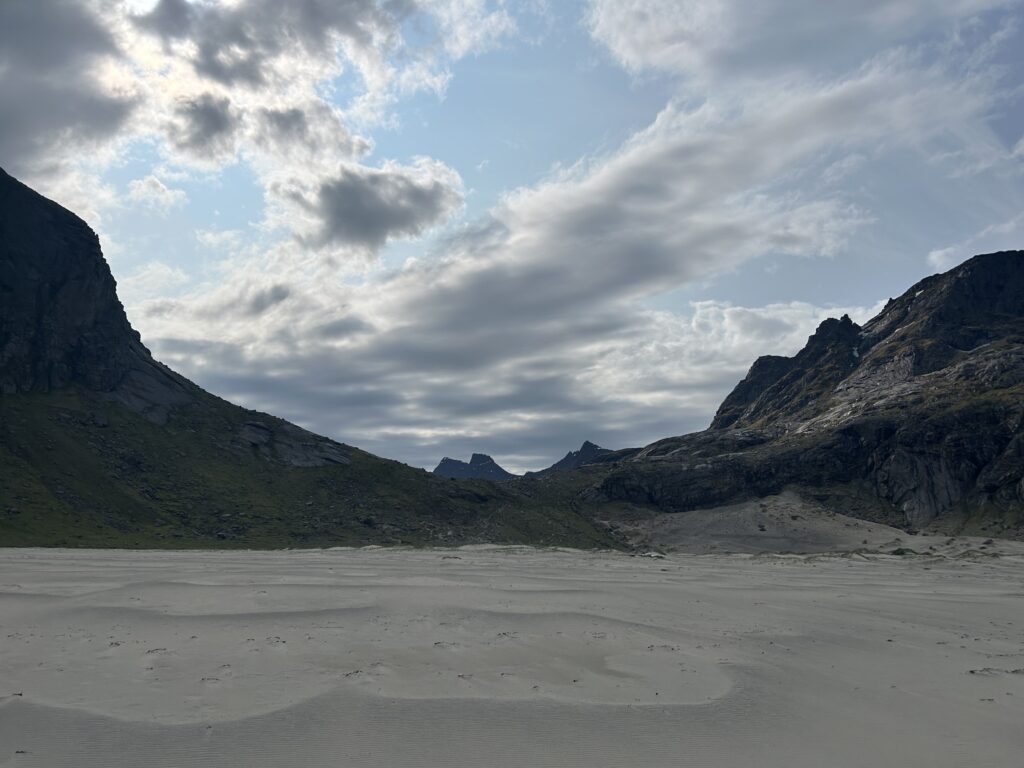
Due to the difficult terrain, progress has been much slower than anticipated and therefore, it has been a very long day. But nonetheless a magnificent day. These are the days I live for. I take a short barefoot walk around the beach before falling promptly asleep. During the night there are some nearby rockfalls (I’m at a safe distance) that wakes me up a couple of times.
For those who want to visit Bunes Beach, which I would definitely recommend that one does, there is an easier way than mine. One can simply take the boat directly to Vindstad from Reine, almost no walking required. There are plenty of people that have done just that, bringing chairs, tables, barbecues, etc.
2025-06-04, Wednesday – One Last Push
I start the day with another barefoot stroll along the beach before I head towards Helvetestinden. I aim to make my way to the small community of houses located at the northern part of Kjerkfjorden. There is no dedicated path to follow, I’m hoping that I will be able to make my way down the mountain from the saddle point located south of Helvetestinden. This is the most uncertain part of the hike, I know that it will be very steep and that a safe passage might not exist.
From the top, I see a route that looks achievable. I can not see the entire way down whether it will work or not, but it looks good enough to gamble. Worst case scenario is that I have to turn back. It is steep, slippery and difficult but I manage to get all the way down. Looking back up, I can not see any other route that looks possible to climb without free soloing, there are simply too many steep rock faces.
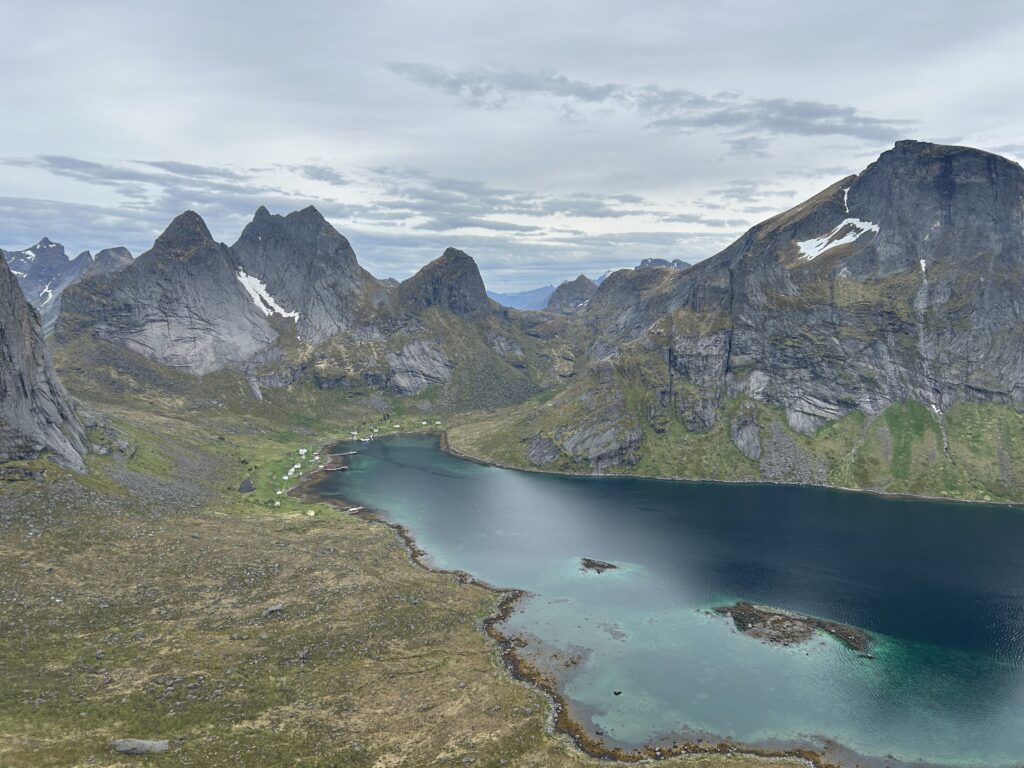
I continue towards Horseseidvika beach and enjoy the rest of my food for lunch. Now almost 24 hours of fasting awaits me before I will have the opportunity to resupply again. I push onward over the ridge towards Selfjordhytta, on the way I spot what I believe to be a Mountain Hare. At Selfjordhytta the fun hiking is over, now a pleasant (ironic) 20 km asphalt walk awaits me to Flakstad where I will spend tomorrow surfing. There are of course worse places in the world where one could be covering 20 km of asphalt. I decided to cover the first 10 km and save the rest for tomorrow morning. Just as I have pitched my tent it starts raining, perfect timing. Surprisingly many French people visit Lofoten this time of year, it feels like 50 % of the people I talk to are French. Or perhaps the French are just super friendly and the only ones that want to speak to me.
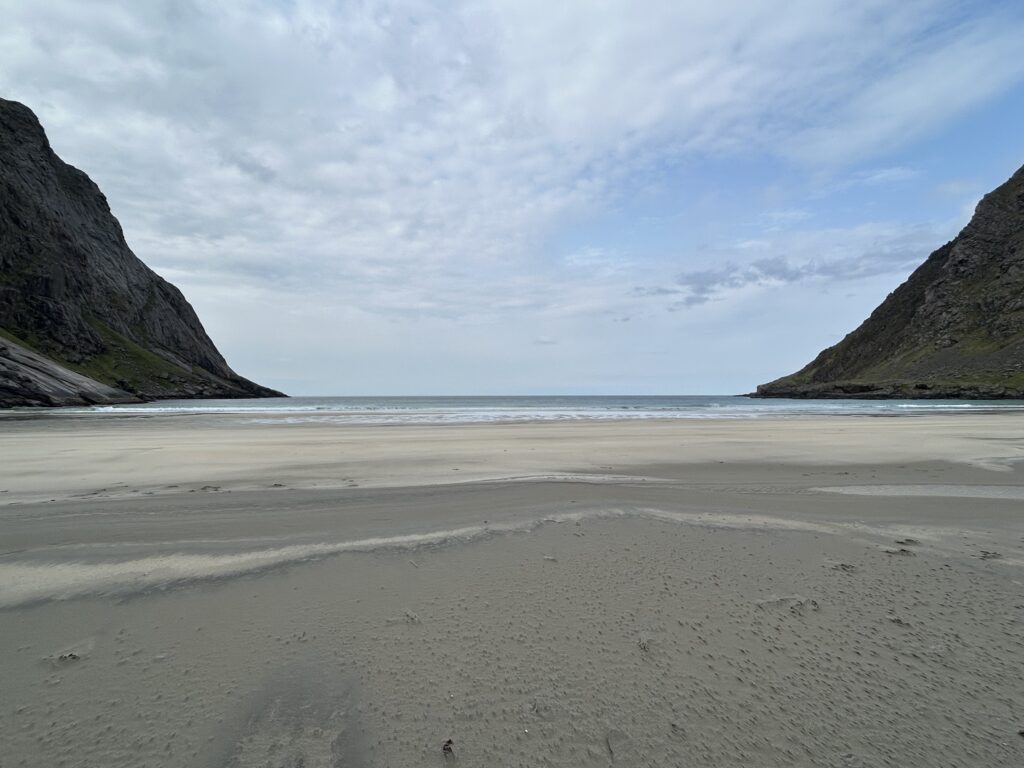
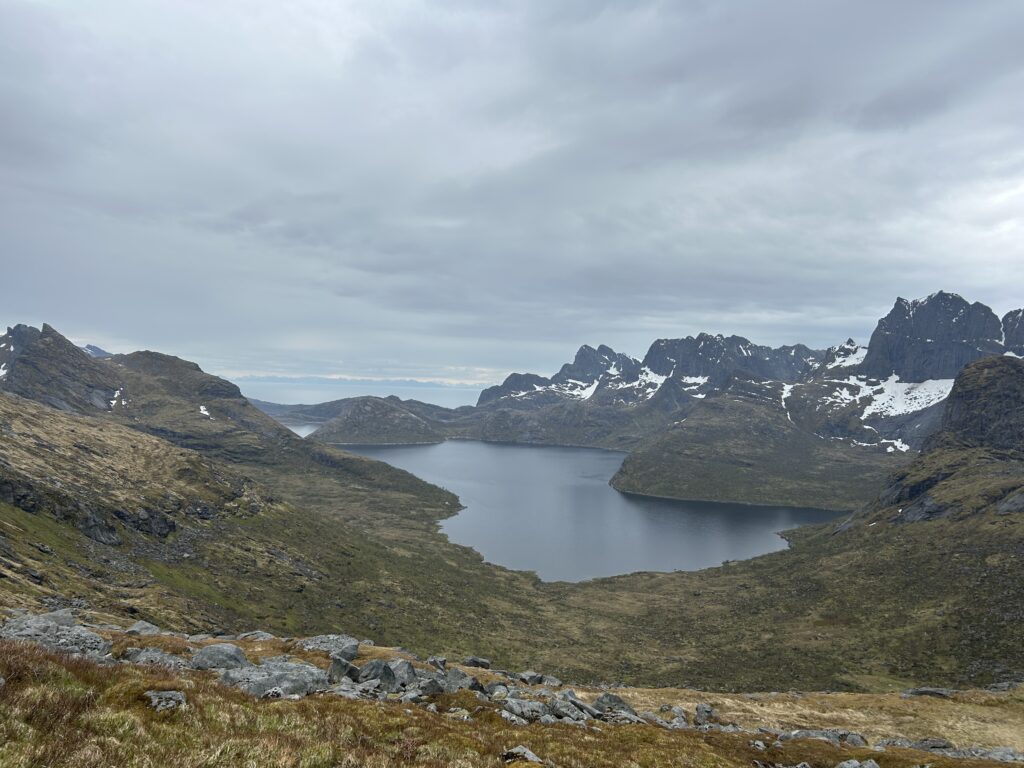
2025-06-05, Thursday – Surfs Up
Surfing time at Lofoten Beach Camp. I can not say that I’m a natural at surfing, but after a while I do start to get the hang of it and I actually manage to catch some nice waves. With enough artistic freedom one might even say I became good at surfing, but that would be a high amount of artistic freedom indeed.
I continue to surf on my own after the class has finished. I’m thinking of continuing for the rest of the afternoon – it is actually quite exhausting but very fun. However, I f* up. I fall off the board, and when turning around after getting back up from the water the surfboard, which has been caught by another wave, hits me straight on my chin. I get back up from the water somewhat dizzy and notice a pool of blood floating around. My first thought is: “my teeth, f*ck”. After poking around a bit with my fingers, I conclude that all of my teeth seem to be fine, nothing is missing and nothing is loose. However, feeling around with my tongue I sense that a bit of my inner lip is missing. I tell myself that it always feels worse than it is, which is usually true but not in this case. It actually looked exactly how it felt. I reckon that there is not too much to do about it now. I will wait a couple of days and see how it heals. Based on my injury, and the fact that there is not even a single dent in the surfboard, it is hard to say anything else than that I lost that battle. But the war is far from over, I will learn to surf one day! Later on, the right part of my chin also got extremely swollen, I looked a bit like Stan from American Dad.
Instead of surfing, I spend the rest of the afternoon in the sauna, interleaved with plenty of ocean dips. With its massive panorama view over the sea, it is probably the nicest sauna I have ever been to. After several days of hiking, it is also very refreshing (and much needed) with a shower.
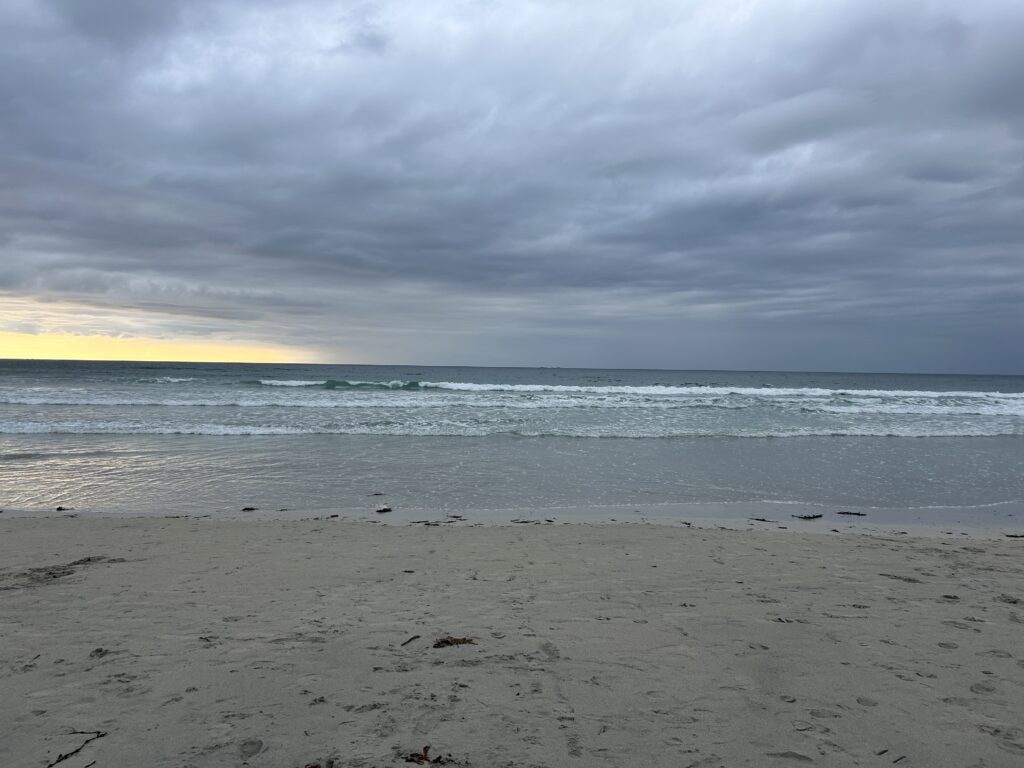
In the evening I hop on the bus to Kallestranda where I will meet up with my friends Douglas and Zainab for some climbing. Apparently there will also be a big climbers party at the beach on Saturday, that should be interesting. It is almost midnight when I arrive at Kallestranda. I’m tired but it’s so nice to meet up with and chat with my friends so it takes a while before I hit the sack.
2025-06-06, Friday – Sweden’s National Holiday
The next morning we head towards some nice cliffs to do some climbing before the rain starts. I always forget how nice outdoor rock climbing is. It is so much nicer than indoor climbing. I have to do more outdoor climbing. I only live 1 hour or so away from Bohuslän, Sweden, which is renowned for its amazing climbing. It is also very nice not having to think about any preparations, Douglas and Zainab, the climbing pros, take care of everything. I feel well taken care of in their company. Douglas and Zainab are doing traditional climbing, where they place their own nuts and bolts on the way up. At the top, they then secure the rope so that I can top rope climb.
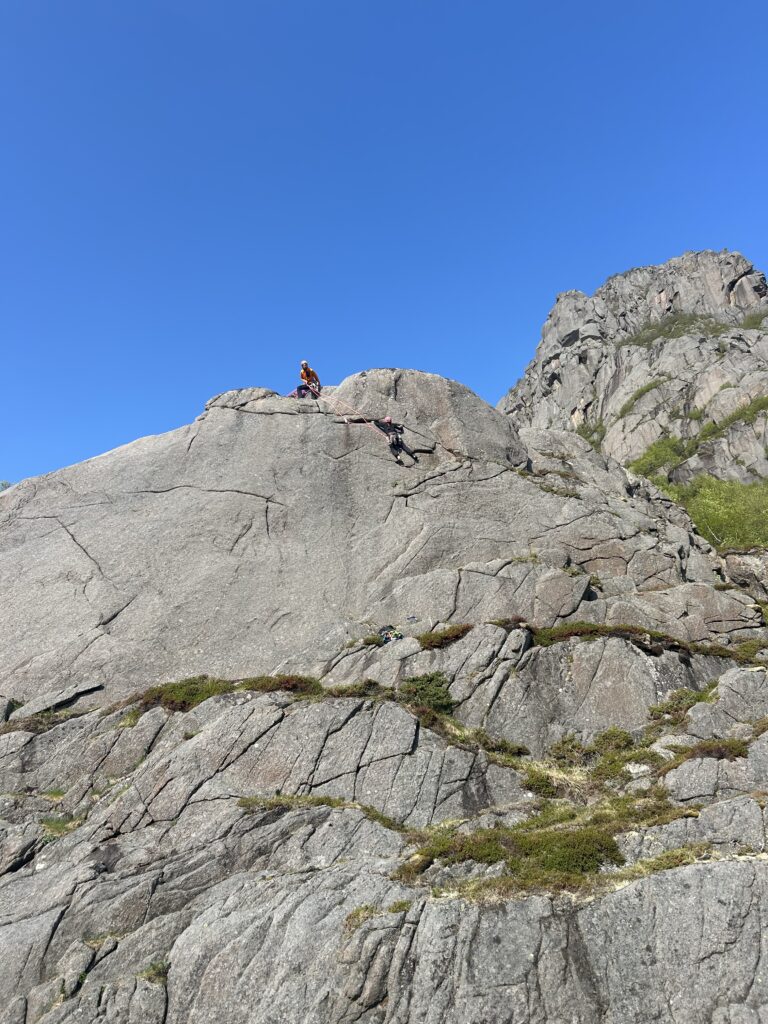
Around noon it starts raining and we spend the afternoon in the tent taking some, at least for me, well needed rest. In the evening the rain stops and we head for another cliff for some late night climbing. Douglas is in charge of the navigation, and what should have been a 20 minute walk turns into a 90 minute plan-less search, at least we saw some really cool terrain, and to be fair that probably made the detour worth it. Douglas said before we started walking that he would really like to run Jukola (a massive orienteering relay in Finland) next year – sure Douglas, but not on my team 😉
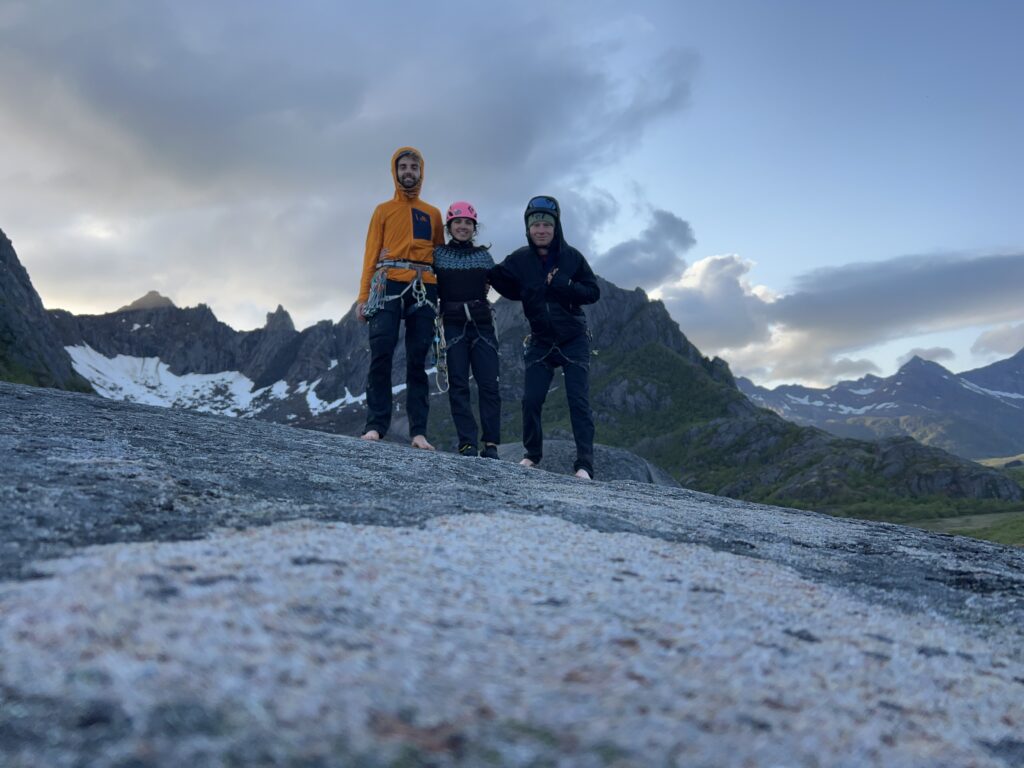
We totally forgot about Sweden’s national holiday. I’m a bad patriot. Next year I promise I will do better.
2025-06-07, Saturday – Beach Party
In the morning two friends of Douglas and Zainab, Henry and Asbjorn, joined us – two really nice guys. They had been climbing a multi pitch yesterday and unfortunately Henry fell and injured his foot pretty badly, and sadly his climbing trip is over. Henry lives in Bodö and will be driving back there tomorrow, considering I’m also going to Bodö tomorrow we decide to go back together.
The four of us that are still able to climb spend the morning doing some crag climbing. This is a major challenge for me as I have little to no experience crag climbing. But I like challenges.
As the day progresses more and more people arrive at Kallestranda, to climb and to participate in the beach party. We for example meet Lydia, a friend of Henry, who is pursuing a PhD in polar sciences, sounds really cool.
In the afternoon Douglas and I go fishing. I have been carrying that fishing rod with me without using it once so far. Time for the rod to pay its dividend. We dash across the sea cliffs looking for a good fishing spot. When we finally find one, we notice that we have lost the handle to the reel. I’m such a master fisherman. It is a good thing that I have carried that fishing rod with me all the time, I did for sure require the extra weight. The scoreboard reads: 2 reels broken, 0 casts taken. Another battle it would be hard to argue against not losing. Oh well, next time I will catch some fish, at least I tell myself that.
The beach party is arranged by the Lofoten Mountaineering club. There are probably around 100 climbers there at least, many from all over Norway. They have grilled several whole Lambs, absolutely delicious, and there is a hot tub, a sauna, and a massive bonfire on the beach. I’m typically not fond of parties, but this was nice.
2025-06-08, Sunday – All You Can Eat Sushi
Henry and I take the ferry from Svolvaer to Skutvik and then make the long drive to Bodö. Henry tells me about the cycling adventure he made last year in Kazakhstan where he cycled the outback for 60 days. It sounds awesome and I became inspired to do something similar. We also talk about his work/studies. He is part-owner in a company, for which he is also doing his masters thesis, that investigates how to grow a certain type of ocean worm that could be used for fish-feed or other applications. As a researcher myself I always find it interesting to discuss research topics.
In the evening I join Henry and some of his friends for an all you can eat sushi buffet. After several days adventuring, my appetite is big enough to devour that buffet.
2025-06-09, Monday – Back to Reality
Flying back to Gothenburg. Tomorrow I’m set to go back to work bright and early. Thanks for this time Norway. I will be back.
I’m super pleased with how the trip unfolded. Nothing to complain about, except my fishing skills. However, next time I go hiking in the Nordics, it will be a proper thru-hike. The only thing this trip is missing is that feeling of “spiritual enlightenment”.
To answer the question “where do Douglas and I meet up next?”. It is now decided that we (hopefully) will meet in Gothenburg in September for a bicycle adventure. In addition, I intend to travel to Scotland next year to attend Douglas and Zainabs wedding – Congratulations to the both of you!

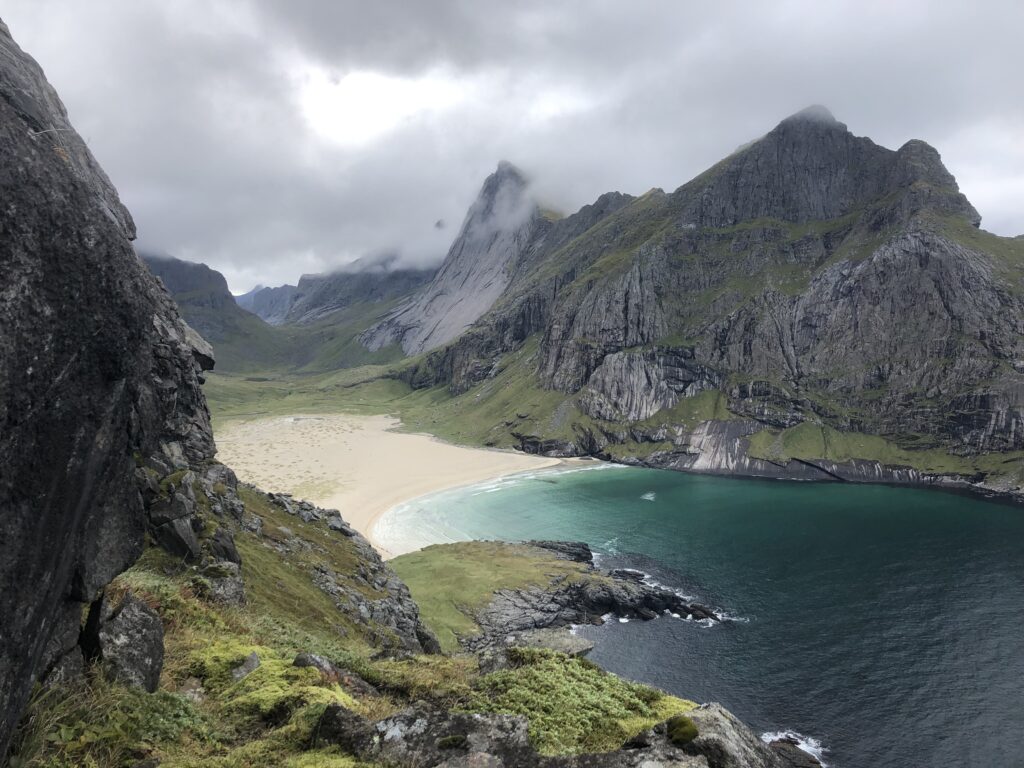
Trevlig läsning och bra skrivit!